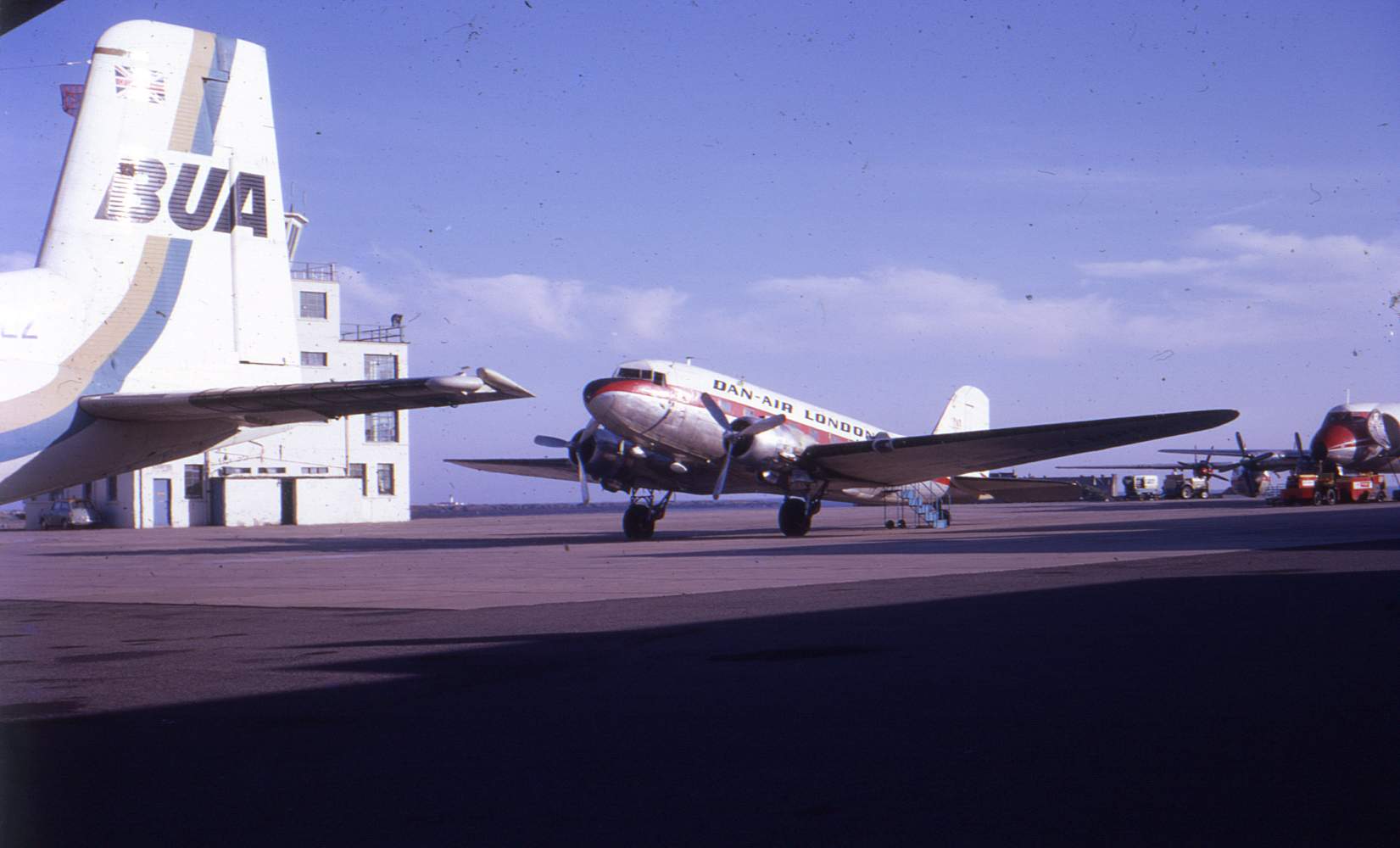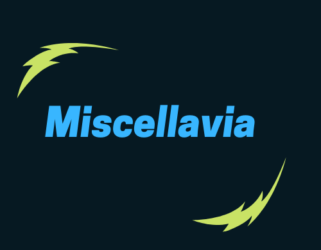Career Highlights 1943 - 1987
* Took part in Operation Overlord with 233 Squadron RAF, June 6th 1944, carrying paratroopers on ‘Tonga’.
* Flew on re-supply operation RobRoy1 on June 6th.
* Resupply mission of August 21st 1944 to assist Polish troops trying to close Falaise Gap unsuccessful owing to bad weather.
* Took part in Market Garden 17th September 1944 towing Horsa glider with 233 Squadron.
* Flew pannier resupply mission to Arnhem on Sept. 21st 1944 with 437 Squadron RCAF.
* Flew on Arnhem resupply mission of Sept 23rd with 233 Squadron.
* In May 1945 assigned to SHAEF operations from Flensburg for 10 days carrying senior allied officers to Rheims, Versailles, Brussels and Salzburg.
* Was one of the first five Dakotas taking 233 Squadron to India. KG437 was one of the only aircraft traveling from Europe to actually fly operations in India before returning to England with 435/ 436 Squadron RCAF.
* After service with 437 Squadron RCAF in England, was demobilised in January 1946.
* Served with British European Airways as G-AGYX with fleet name ‘George Holt-Thomas’.
* Brief appearances in British movies ‘The Lavender Hill Mob’ and ‘The Teckman Mystery’.
* Converted to 32- seat Pionair configuration by Scottish Aviation.
* Sold by BEA to Autair and operated IT flights for them and also on lease to Skyways Coach Air.
* Sold to Libyan Aviation in 1962 but maintained British registration.
* Sold by Shackleton Aviation to Martin’s Air Charter in 1965 as PH-MAG. Became well-known throughout Britain and Europe.
* Joined Moormanair Holland in October 1968.
* Sold to Scorpio films in May 1973 to become the ‘star’ of Dutch film ‘Dakota’.
* Sold by Scorpio to Nigerian Trade Wings in March 1974. Operated extensively from Malta as 5N-ATA on oil company charters across North Africa.
* By 1980, appeared near derelict in Khartoum but managed to reach Malta again by 1983 where she became a ‘spares queen’.
* Eventually, remnants of aircraft sold to owner of ‘Dakotas’ Bistro and shipped to the UK. Nose section sold to RAF Museum in 2002 and restored by Medway Aircraft Preservation Society before delivery to Hendon in January 2006.
MILITARY CAREER:
KG437, s/n 12472, was built in Oklahoma City as 42-92648 for the USAAF and delivered on 4th February 1944 (1). Supplied to the RAF under the Lend/ Lease scheme, the Dakota III arrived at RAF Dorval, Montreal, on 14th February and had crossed the Atlantic to Britain by 23rd February. The Dakota is recorded as joining 233 Squadron six days later on February 29th 1944 (a Leap year). It seems likely that KG437 would be delivered to 233 at their Gosport facility but it is possible that she went direct to RAF Bircham Newton in Norfolk. Either way, the main party of squadron personnel occupied their new home at Blakehill Farm on March 5th and, two days later, the first twelve Dakotas arrived ready for conversion training. KG437 was probably one of these aircraft and would have commenced familiarisation training during the remainder of March as the Dakotas were fitted-out for airborne operations.
Training for ‘Operation Overlord’ was commenced and continued during April 1944 as further crews arrived from conversion training. Exercises in pannier deployment, paratroop dropping, precision navigation and day/ night formation flying were carried out using bases such as Netheravon. Glider towing was practiced following the collection of Horsas from North Luffenham and Swanton Morley. Paratroop drops were carried-out at various locations including Netheravon and Stonehenge with the participation of the 1st Canadian Parachute Battalion which had been assigned to assist. KG437, as one of the first Dakotas to arrive, would have been prominent in these operations and, by April 22nd, up to 22 Dakotas were being flown on individual exercises.
(1) Main dates from the Air Britain publication ‘The Douglas DC-1/ DC-2/ DC-3: the first 70 years by Jennifer Gradidge.
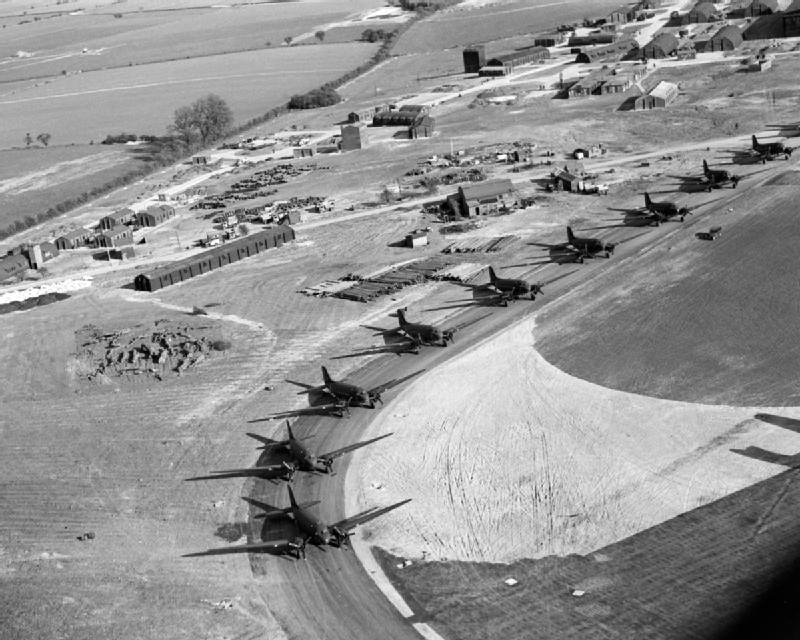
On the night of 25th/ 26th April, 233 Squadron’s first active mission was carried-out with the Commanding Officer, Wing Commander Morrison, flying KG431 at the head of a flight of three Dakotas on a ‘nickelling’ mission to drop propaganda leaflets over France. KG437 was not on this operation but possibly took part in subsequent missions leading up to D-Day.
On June 2nd 1944, all 233 Squadron Dakotas scheduled to take part in the Normandy landings were air-tested and crew equipment checked-out. Six aircraft were due to tow Horsa gliders to Normandy followed by 24 aircraft carrying paratroopers. The target zone ‘K’ at Toufreville was assigned to 233 Squadron for Operation ‘Tonga’ and the airborne troops were to be the 8th Parachute Battalion of the 6th Airborne Division.
KG437 was one of the 24 troop-carrying aircraft and was captained by Flying Officer J.A.Stewart with Flying Officer D.Todd as Second Pilot. FO Phillips was the navigator and FL Bradley the wireless operator. The 24 Dakotas began their take-off sequence at 23:11 on June 5th with KG437 recorded as being airborne at 23:14. The operation was largely successful and KG437 was back home at Blakehill Farm at 02:54 on June 6th. The Dakota also took part in the succeeding re-supply operation , Robroy 1, on the evening of June 6th, again with FO Stewart’s crew. Airborne at 22:24, KG437 was safely home at 01:37 on June 7th.
Allied sappers started work establishing advanced airstrips in Normandy as soon as the front line had moved sufficiently inland. The first British landing ground, B1, was just inland from Gold Beach and opened on June 10th. B2, Bazenville, and B3, Croix-sur-Mer, were also a scant three miles from Gold Beach and, for the first few weeks after D-Day, remained just a few kilometres from the front line. KG437’s first mission to the continent was on June 15th as part of a seven-aircraft operation transporting the personnel of RAF 144 Wing from Ford to B3. The transports were escorted by RAF Spitfires but no enemy opposition was encountered. Flying Officer Haldimond was in command and his crew would have included female WAAF nurses who had been carried on 233 Squadron flights taking part in casualty evacuation since June 13th. The seven Dakotas were able to evacuate a total of seventy-five stretcher cases and thirty-nine walking wounded to Blakehill Farm.
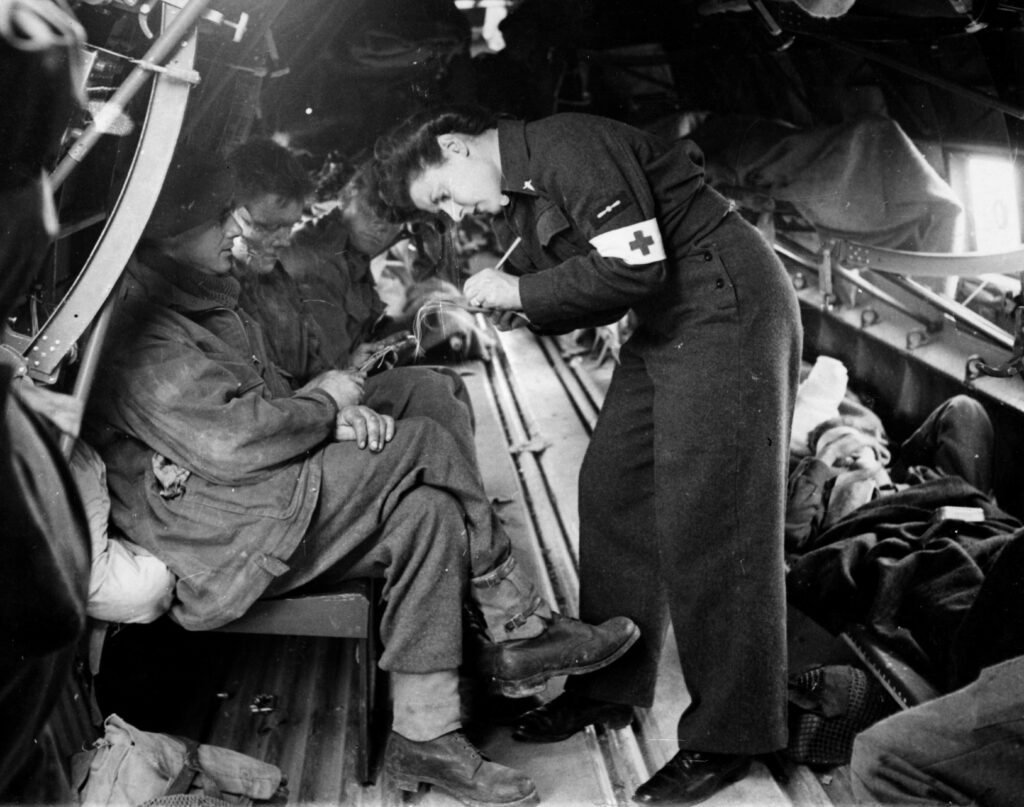
June 16th saw Flying Officer Stewart’s crew in KG437 delivering screw pickets to B5/ Le Fresne Camilly in the company of FZ681. The airstrip was only around one mile from the front line and German shelling was being accurately directed by artillery spotters on the Scheider steelworks towers in Caen. An RAF Dakota had been destroyed the previous day and, within five minutes of their arrival, the pair of 233 Squadron aircraft were under fire. Unloading quickly, the Dakotas took off, heading for the slightly safer B2 strip at Bazenville. Here, they embarked 24 stretcher cases and five sitting wounded. A repeat visit to B3/ St Croix for FO Stewart’s crew and KG437 on June 20th proved slightly less traumatic with the outbound cargo of bombs (mortar bombs?) offloaded safely. Casualty evacuation had been scheduled for the return but there were no customers at the airstrip.
There was a lull for KG437 until June 29th when she was part of a 19 aircraft mission carrying 93 personnel of the Forward Staging Post from Blakehill Farm to B8/ Sommervieu, east of Bayeux. On July 2nd KG437, flown by Flt.Lt Holdsworth, was back at B8/ Sommervieu with ammunition carried outbound and casualties on the return. The only other two missions for the month seem to have been newspaper deliveries from Thorney Island to B14/ Amblie on 23rd and 25th July. Amblie Advanced Landing Ground was just south of B3/ St.Croix and close to the HQ of the 1st Canadian Army. Constructed by the Royal Engineers as an RRS (Re-arming and Refueling Strip) it was used largely for personnel movement and casualty evacuation. Flt.Lt Haldimond was at the controls on 23rd, FO Stewart on 25th and both return flights carried evacuated casualties.
On August 2nd Flt. Lt Broadley piloted KG437 as one of six 233 Squadron Dakotas positioning from Blakehill Farm to Northolt in order to collect elements of the 2nd Tactical Air Force. Army and Air Force personnel and 16,450 lbs of equipment/ stores were transported to B8/ Sommervieu. The Dakotas returned via Amblie (indistinct) with casualties on board. Two days later, FO Stewart’s crew flew on a similar mission from Northolt to B8, returning with casualties. The pattern for operations for KG437 remained very similar throughout August:
7th August: Pilot Officer Roy carried mail and passengers to B14/ Amblie, returning with casualties and mail.
21st August: German counter-attacks attempted to hold the neck of the ‘Falaise pocket’ open to facilitate retreat eastwards. Polish troops had been cut-off around Mt.Ormel and a high-priority delivery of ammunition panniers was requested to a drop zone near Chamois. After several days of clear skies, the weather had deteriorated and only four of the ten Dakotas were able to find the DZ. Fortunately, the Allies were able to close the Falaise Gap the same day and German resistance in Normandy was largely over. The four successful aircraft had delivered sixty panniers to the ground forces but the remaining six, KG437 included, returned to base without success.
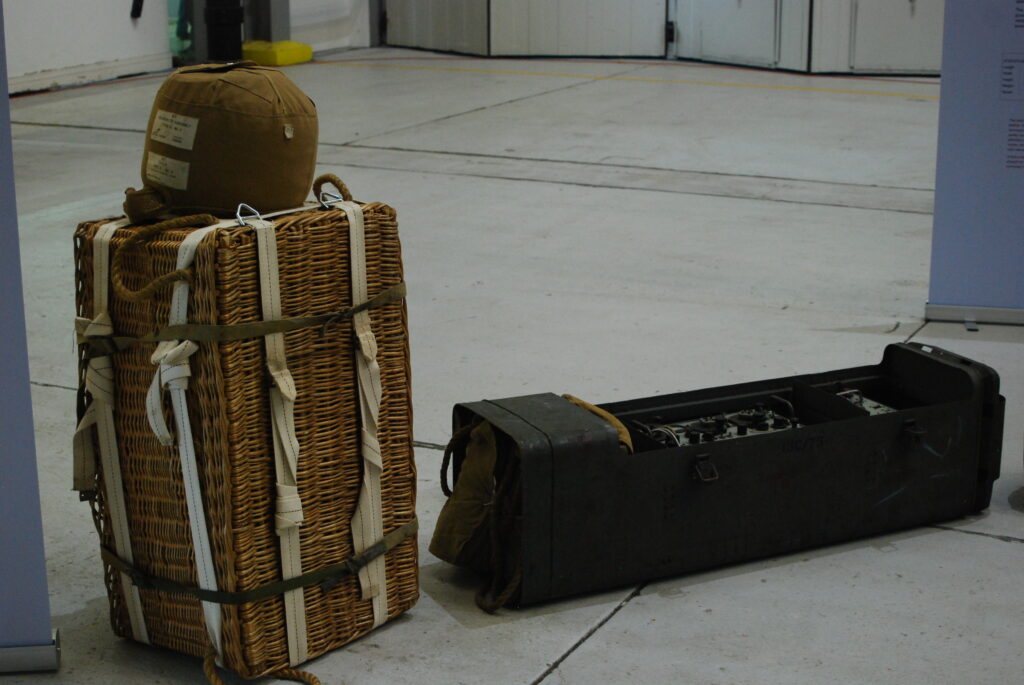
August 24th: The US Major General Cook had taken Orleans and the French General LeClerc’s forces pushed ahead into Paris. The Allies saw that the liberation of Paris would leave the French Capital’s population on the edge of starvation and it was decided to divert some of the airborne logistical effort to fly-in massive amounts of food.
August 27th: Just after midday twenty four 233 Squadron Dakotas lifted from Blakehill Farm en route to Orleans with food and stores. KG437, flown by FO Stewart, was the eighth aircraft airborne and was back at base at 15:07.
August 28th: Warrant Officer Russell repeated the food delivery to Orleans as part of a 20-aircraft lift.
August 29th: FO Stewart piloted KG437 on a 21-aircraft mission delivering food to Orleans.
August 30th: KG437 and FO Stewart were again part of a 21-aircraft to Orleans, returning via B21/ St.Honore.
During September, the Allies moved rapidly through Europe towards the Rhine, stretching logistics to the limit. Petrol supplies and armaments were the priority on the outbound leg and an increasing number of advanced landing grounds were opened-up. The liberation of Brussels by the British Army on 3rd September produced an excellent centre for RAF Transport Command for the remainder of the War.
Flying Officer J.Stewart’s crew were at the helm of KG437 on September 10th when a petrol delivery flight was run to B60/ Grimbergen. The following day, the same team delivered petrol and oil to B56/ Brussels-Evere. A double petrol delivery was run to B60/ Grimbergen on 12th September as part of a 23-aircraft operation assisting the Allies on their push towards the German border. September 13th saw the Stewart crew flying KG437 again as part of an eleven aircraft lift carrying ammunition to another Brussels area strip, B58/ Melsbroek. This was the last mission prior to the Arnhem operation.
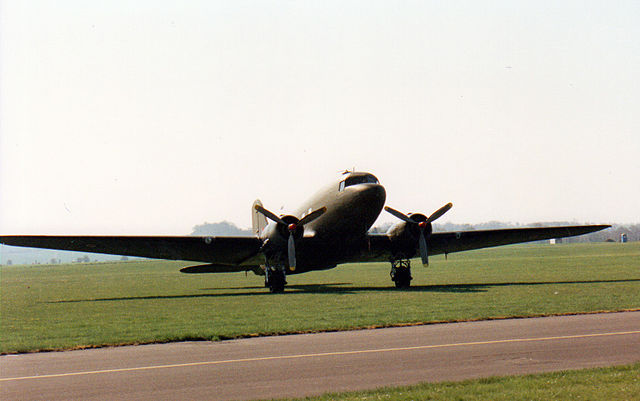
On Sunday September 17th KG437 took off from Blakehill Farm at 10:08 as one of twenty-two 233 Squadron Dakotas towing Horsa gliders as part of the Market Garden operation. The Dakota was crewed by the regular team: Captain FO J.Stewart, Second Pilot FO D.Todd, Navigator FO R.Phillips and Wireless Operator FO W.Bradley. The gliders, carrying troops of the British First Airborne Division, were successfully released west of Arnhem over Landing Zone ‘S’. Little enemy opposition was met and the Squadron returned safely to Blakehill. The following day, FO Stewart piloted KG437 to B59/ Ypres with newspapers before continuing to B43/ St Omer to collect casualties. There were none at the airstrip, so the aircraft returned empty to base. FO Stewart was in action again on September 20th but with a passenger operation from Northolt to B6/ Coulombs rather than a Market Garden mission. Passengers were carried on to B56/ Brussels Evere and KG437 stayed there overnight before returning to Coulombs to collect casualties for evacuation to Down Ampney. 437 Squadron RCAF logs record that KG437 flew a mission with them on September 21st. This is quite possible as 233 and 437 shared their base at Blakehill Farm the the Canadian outfit had only just become operational ina time for Arnhem. 437 Squadron had flown their first missions with many Canadian crew transferred from 233 and with some ‘borrowed’ 233 Dakotas. The operation on 21st was a 10-aircraft mission to deliver panniers to Arnhem and suffered a number of losses following FW190 attacks on the return leg. KG437, flown by FO W.E.McLean, was undamaged and landed back at base at 18:32. KG437 was back with 233 and FO Stewart’s crew for the resupply flight of September 23rd. By now, there was real doubt that the airborne forces on the ground were receiving the panniers dropped by the Allies. Departing Blakehill at 13:18, KG437 was back on the ground at 18:55.
On September 25th, FO Stewart’s crew flew a logistics mission to Brussels. The Belgian capital was the centre of much allied activity as Market garden drew to a close and the 233 Dakota had to land at B60/ Grimbergen rather than the intended destination of B56/ Evere. Casualties were carried on the return flight. FO Stewart and KG437 were part of an 8-aircraft mission to deliver Typhoon drop tanks to B59/ Ypres on 27th September. KG437 and KG315 carried 50 passengers between them on the return sector to Northolt. Later the same day, the Stewart crew flew KG437 north from Blakehill to Matlaske in Norfolk in the company of ten other 233 Dakotas tasked with moving air force personnel and equipment to B60/ Grimbergen. The eleven aircraft flew to Grimbergen on the morning of September 28th and, after unloading, returned to Matlaske with equipment and passengers. KG437 and three other Dakotas then returned empty to Blakehill farm while the remainder overnighted at Matlaske. The next morning, FO Vines’ crew in KG437 and another crew in FZ665 transported 44 passengers to Matlaske before repositioning to Bicester to collect drop tanks destined for B56/ Brussels Evere. KG437 returned empty to Blakehill. The final mission for the month took place on September 30th and featured FO Stewart piloting KG437 from base to Hawkinge as part of a six-Dakota operation to collect passengers and equipment belonging to 130 and 441 Squadrons. The personnel were then delivered to B70/ Antwerp and passengers and freight from 132 and 441 Squadrons uplifted for return to Hawkinge.

Following the failure to capture the bridge at Arnhem, the early part of October 1944 was spent consolidating the gains that had been made during Market Garden. KG437 was in operation most days during the month:
October 1st: FO J.Stewart’s crew was one of ten flying petrol to Evere.
October 2nd: FO Stewart and KG437 were part of a 17-aircraft mission to deliver petrol to B56/ Brussels-Evere. Four passengers were carried on the return sector to Northolt.
October 4th: Flt.Lt Broadley was captain of KG437 on a 14-Dakota operation taking ammunition to Evere. Mail was flown back to Britain.
October 8th: Flt.Lt Cody DFC DFM flew from Blakehill to Northolt where 17 passengers were collected for transport to B56/ Brussels. Staying overnight, the crew returned to Northolt with 20 passengers.
October 10th: FO J.Stewart took KG437 as one of six Dakotas on a mission delivering 25 pounder ammunition to B56/ Evere. KG437 and KG448 returned to Broadwell carrying a total of 31 stretcher cases and 8 walking wounded.
October 11th: FO Vines delivered mail to B61/ Sint-Denijs before continuing to B56/ Brussels with a load of drop tanks. Returning empty, KG437 landed at Redhill owing to poor weather in the Chilterns.
October 13th: FO Stewart was at the controls of KG437, one of five Dakotas delivering 25 pounder ammunition to B58/ Brussels-Melsbroek. The return to Blakehill Farm was flown empty.
October 15th: FO Stewart took KG437 as one of fourteen 233 Sqdn Dakotas transporting 137 Wing personnel and kit from Hartford Bridge (Blackbushe) to B50/ Vitry-en-Artois. Stretcher casualties were carried to Broadwell on the return.
October 17th: FO Stewart’s crew flew 437 as part of a 7-aircraft operation taking ammunition to B58/ Melsbroek. After an overnight stay, the aircraft returned to base empty.
October 19th: PO Wright’s crew took off at 11:10 en route to B70/ Antwerp Deurne on a 15-aircraft operation delivering ammunition. Other members of the crew were Flt.Sgt. Cooper, Warrant Officer White, Flt. Sgt. Lewis. They were back home at Blakehill at 16:23.
October 20th: Flt.Sgt. Diamond’s crew were airborne at 10:34 en route to B70/ Antwerp with 2000 lbs of newspapers. Return empty to Blakehill at 16:24.
October 22nd: FO Smith flew 4500 lbs of newspapers to B58/ Melsbroek, stayed overnight and then returned to Down Ampney with 18 stretcher cases.
October 26th: The CO, Wing Commander Coles, flew KG437 as part of an 8 aircraft operation delivering ammunition and stores to B70/ Antwerp, returning on 27th.
October 28th: FO Stewart took 5000 lbs of mail to B58/ Melsbroek before continuing to B17/ Caen Carpiquet with three passengers. One passenger and 4220 lbs of mail were returned to base.
October 29th: FZ681 and KG437, flown by FO Stewart, delivered a total of 10,260 lbs of miscellaneous freight to B50. Vitry-en-Artois.
The end of October 1944 was quite quiet but KG437 was back in action on November 6th when FO Stewart flew as part of a 6-aircraft operation tasked with dropping panniers to allied forces engaged in sweeping-up German resistance around Antwerp. The Dakotas flew to B70/ Antwerp before taking-off again to head for the target drop zone, the beach to the NW of Flushing/ Vlissingen. Following a successful drop, the six Dakotas returned to B70 and then to Blakehill Farm. On November 14th a group of eight aircraft from 233 Squadron delivered Pierced Steel Planking from Lyneham to B79/ Woensdrecht. FO Stewart was at the controls of KG437 on 14th and PO P.Diamond was in command the following day when 11 aircraft repeated the Lyneham to B79 PSP delivery.
FO Stewart’s crew took KG437 to B78/ Eindhoven on 18th November as part of a quartet of Dakotas delivering army freight. The same crew and aircraft flew to B72/ Cambrai (?) the following day as part of 11 aircraft delivering 99 passengers of 138 Wing from Blackbushe to the Continent. 20th November saw Flt Lt Mackie’s crew (with FO J.Proctor and Flt.Lt D.Goodwin) carrying mail and freight from Blakehill Farm to B58/ Melsbroek, mail from Melsbroek to B17/ Caen and freight from B17 home to base. The next day, November 21st, saw FO Diamond captaining KG437 on a passenger flight from Northolt to Eindhoven with 25 personnel. Positioning to B58/ Melsbroek, the aircraft remained on the ground for two days owing to bad weather. Back at Blakehill on 23rd, KG437 wasn’t back in action until November 27th. On that day, Flt.Lt Haldimond’s crew delivered PSP to B53/ Merville, returning empty. On 29th November Flt.Lt Vines delivered 3000 lbs of ammunition to B77/ Gilze-Rijen before transiting to B58/ Melsbroek to collect 20 passengers bound for the USAAF airbase at Wethersfield in Essex.
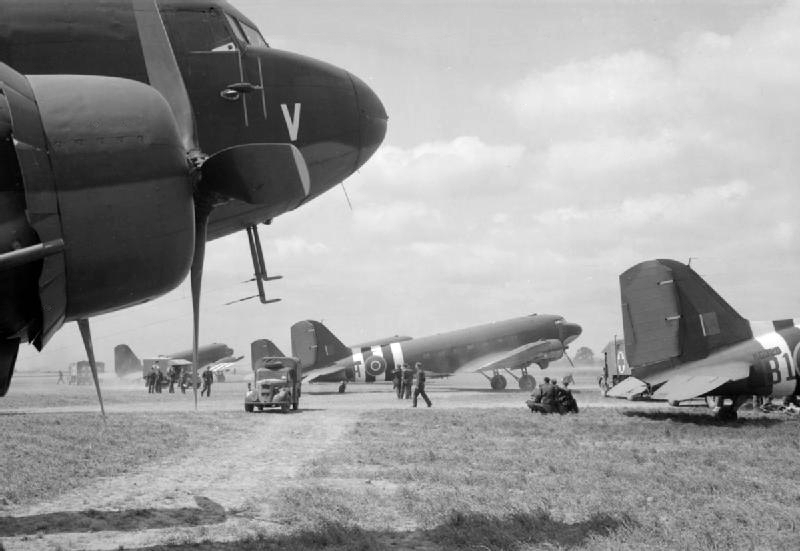
On December 1st 1944, WO Lee routed from Blakehill farm to Bicester and then onwards to B58/ Brussels Melsbroek with army freight. From Brussels, KG437 flew west to Perranporth in Cornwall carrying personnel and kit. December 2nd saw KG437, flown by Flt.Lt Broadley accompanying KG415 on a petrol run to Bordeaux, Merignac. 9000 lbs of fuel was delivered and, following an overnight stay, the two aircraft returned home via Le Bourget. Warrant Officer Holliday captained KG437 on 5th December with a 10:04 departure from Blakehill as part of a 7-aircraft freight mission heading for B77/ Gilze-Rijen. The next day, 6th, Flt.Lt Barlay’s crew departed Blakehill at 11:36 en route to Brussels with freight. The aircraft landed at B58/ Melsbroek as B75/ Nivelles was closed and, subsequently, returned home empty. The aircraft returned to Gilze-Rijen on 11th December with tank track segments and gun spares and on 12th December as part of a 14 aircraft lift carrying ammunition. On the second occasion, Flt.Lt Barlay returned to Blakehill via Fairwood Common with 9 passengers bound for the Welsh airfield.
B58/ Melsbroek was the destination on 18th, 22nd and 26th December. Flt.Lt Barlay was the Captain on 18th when three Dakotas carried army stores on the way out but nothing upon the return. On 22nd, it was FO Smith carrying mail outwards as part of a 5 aircraft mission. On return from Melsbroek, KG437 and FZ688 carried 32 passengers and 5 prisoners of war. On Boxing Day 1944, KG437 carried 2 passengers to Melsbroek and remained there for three nights, returning to Blakehill with 18 stretcher cases and 6 walking wounded. Pilot Officer White was at the controls on December 30th for a flight carrying AFV spares to B70/ Antwerp before returning to Blakehill and Down Ampney with mail. On the last day of 1944, WO Curtis departed Blakehill on the short hop to Odiham to collect five members of 604 Squadron bound for B51/ Lille. The return flight carried 10 USAAF personnel to Horsham St.Faith.
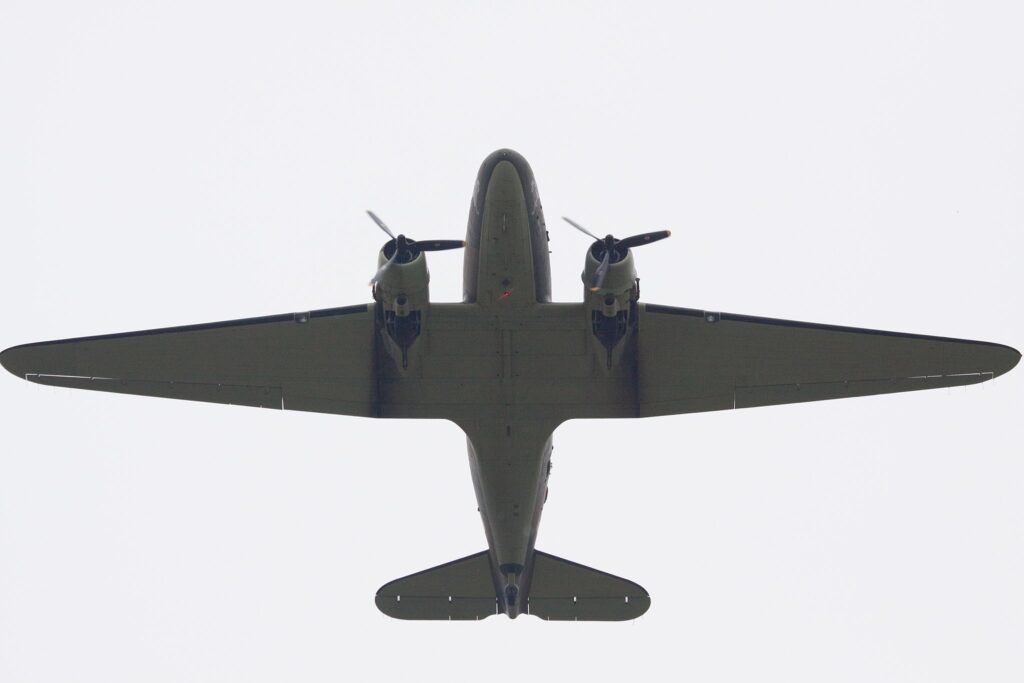
1945 started with general transport duties for KG437. FO Todd flew her on a mixed freight flight to Melsbroek on 3rd and FO Merricks’ crew went to B75/ Nivelles on 6th January. The next day FO Diamond and KG437 departed Blakehill Farm en route to B78/ Eindhoven with a load of spares but had to divert to Melsbroek owing to bad weather. KG437 isn’t recorded as flying again operationally until 28th January when Flt.Lt Cody carried two aircraft propellers to Melsbroek before returning empty. FO Merricks flew KG437 to B75/ Nivelles with 4800 lbs of supplies on January 29th, returning with 25 passengers bound for Northolt.
Multi-aircraft transport missions were the order of the day for KG437 during February 1945:
February 1st: WO Mills was in command for an eight aircraft mission carrying 40,000 lbs of mixed freight to B75/ Nivelles.
Feb 2nd: FO Merricks’ crew carried airborne supplies to Nivelles as one of 13 Dakotas. Empty return leg.
Feb 3rd: FO Hunter took KG437 as 1/12 Dakotas carrying airborne supplies to B75/ Nivelles, continuing empty to B56/ Brussels Evere to uplift 18 stretcher cases and 6 walking wounded destined for Down Ampney.
Feb 4th: WO Evered crewed KG437 as 1 of 7 aircraft carrying signals equipment from Melton Mowbray to Nivelles. There appeared to be some problem with the aircraft (wheel?) in Belgium and WO Evered only returned (empty) to base on Feb 5th.
Feb 7th: WO Evered’s crew transported 24 army personnel to Northolt.
There was a break from transport duties on 8th February for glider training ahead of the projected Rhine Crossing. On 9th February FO Merricks was back in command for an 8 aircraft mission carrying troops to Nivelles. The same crew remained with KG437 for the next few flights:
Feb 10th: 5000 lbs of RAF freight taken to B50/ Vitry-en-Artois.
Feb 11th: Multi-aircraft shuttle service from Blakehill to Nivelles.
Feb 13th: Multi-aircraft shuttle to Nivelles.
Feb 14th: One of ten Dakotas taking 194 troops to B75/ Nivelles, shuttling to B57/ Lille to collect casualties bound for Down Ampney.
Feb 21st: Still the Merricks crew for a transport flight from Blakehill to Newmarket to Nivelles, returning via B78/ Eindhoven to collect casualties bound for Down Ampney.
Feb 22nd. WO Neal was the captain on an 11-aircraft mission taking parachutes and drop tanks to Nivelles, returning to Netheravon with 217 troops. The Dakotas then returned empty to Nivelles to collect a second batch of 219 troops heading for Netheravon.
Feb 23rd: Sqdn Leader Blythe DFC flew KG437 as one of nine Dakotas carrying panniers and parachutes to Nivelles, returning to Blakehill with 179 6th Airborne troops.
Feb 26th: WO Wood flew 437 to Nivelles as one of ten aircraft delivering troops.
Feb 28th: WO Evered took off from Blakehill with Polish Red Cross supplies destined for A82/ Verdun. Bad weather resulted in a diversion to A64/ Saint Dizier and, subsequently, an overnight stay at Verdun prior to returning to Blakehill, empty, on March 1st.
WO Evered’s crew were back in KG437 on March 2nd for a 2-aircraft flight carrying 10,000 lbs of tracking to B75/ Nivelles, returning to Down Ampney with 12 walking wounded whichhad been uplifted from B65/ Maldegem.
March 3rd: Pilot Officer Warburton commanded KG437 on an 09:00 lift as one of three Dakotas taking 15,000 lbs of stores to B75/ Nivelles, returning with 57 US personnel bound for Honington. It was another passenger flight the following day, March 4th, with Flt.Lt Cody taking 13 personnel from Northolt to Nivelles, returning to Blakehill via Northolt with 21 passengers. PO Warburton and KG437 accompanied FZ681 on March 6th with an 08:26 lift taking 40 Canadians to Evere. Another two aircraft mission followed on March 7th, delivering Spitfire drop tanks to B56/ Brussels Evere. On March 9th, PO Morrison commanded KG437 as part of a 6-aircraft operation delivering pharmaceuticals to A93/ Liege-Bierset and returning to Warmwell with passengers. More missions to Brussels followed with Flt.Lt Bentley delivering panniers to Evere on the morning of March 11th and following-on with a second mission to B56/ Evere carrying steel tracking. March 13th saw KG437 taking army freight to Nivelles as part of a 10-aircraft armada which returned to Blakehill empty. There was a further short break from logistics flights on March 14th for a glider-towing exercise. WO Evered was back at the controls of KG437 on 15th March for another 10-Dakota mission – this time delivering equipment from Perranporth to B56/ Evere. A final pre-Operation Varsity flight took place on March 20th with Flt.Lt Bentley flying KG437 to Perranporth to collect 15 personnel and their kit. the passengers were delivered to Rennes and the Dakota returned to Blakehill with six personnel.
There was no operational flying on March 21st as twenty-six 233 Squadron Dakotas prepared for Operation Varsity, the Rhine Crossing, by flying to Birch airfield in Essex. This time, KG437 was not one of the 24 Dakotas towing gliders on the airborne mission and her next flight was recorded as being on March 26th. Flt.Lt Priestley was in command for an 09:16 lift from Blakehill for a 2-aircraft operation delivering cluster bombs to B56/ Evere. The return leg was to Honington with 26 USAAF personnel. Arriving back at Blakehill at 15:23, the aircraft is recorded as being airborne again at 15:33 with Flt.Lt Bentley en route to B75/ Nivelles as part of a 3-aircraft mission delivering 15,179 lbs of army freight. This seems like an exceptionally short turn around, so it is possible that the flight with Flt Lt Priestley (who usually flew FZ681) involved a different aircraft. On March 30th Flt.Lt Bentley was back in charge of KG437 as part of a 2-Dakota mission delivering drop tanks to B65/ Maldegem, transiting to B78/ Eindhoven to collect 44 glider pilots for return to Down Ampney. On the final day of March Sgt Neil flew KG437 from Blakehill to Broadwell to collect RAF freight bound for B75/ Nivelles. One walking wounded and thirteen stretcher cases were then collected from B100/ Goch, KG437’s first landing in Germany, for return to Down Ampney.

April 2nd: Flt.Lt Bentley’s crew was one of eight delivering passengers and kit from Fairwood Common to B85/ Schijndel in Holland before returning empty.
April 3rd: Flt.Lt Bentley was again in command of 437 for a 10-Dakota operation which positioned from Blakehill Farm to Warmwell to collect passengers and kit of 438 Squadron for transfer to B100/ Goch. The return flight shipped 443 Squadron passengers back to Warmwell.
April 4th: Pilot Officer Diamond in KG437 delivered spare parts to B75/ Nivelles.
April 5th: Flt.Lt Bentley transported 12 airmen and kit from Northolt to B56/ Brussels Evere, returning empty.
April 6th: Flt.Lt Bentley’s crew delivered 5000 lbs of freight to A54/ Paris Le Bourget.
April 8th: Pilot Officer Morrison was in command of KG437 as part of a 6-aircraft mission delivering Merlin engines to B78/ Eindhoven, returning empty.
April 9th: Pilot Officer Morrison was again in command for a similar 5-Dakota mission delivering Merlins and returning to Down Ampney with evacuated casualties.
April 13th: FO Warburton took KG437 as one of ten Dakotas delivering petrol to B108/ Rheine before transiting to B56/ Evere to collect steel matting for delivery to B116/ Wunstorf.
April 14th: Flt.Lt Bentley in KG437 accompanied a second Dakota delivering fuel from Greenham Common to R13/ Hessich. Flying back to Y30/ Le Havre-Octeville, the two aircraft boarded 52 ex-POWs for the flight back to RAF Wing.
April 15th: Another petrol delivery mission saw KG437 and six other Dakotas outbound to B108/ Rheine. From there, the aircraft carried ex-POWs to B56/ Brussels Evere before taking a second load of fuel from Brussels to Rheine and returning, empty, to base.
April 16th: WO Neal was in command for a six aircraft operation delivering army freight from Netheravon to B108/ Rheine. 139 French ex-POWs were transported back to B56/ Evere where another load of fuel for Rheine was uplifted. The next sector was flown empty to R16/ Hildesheim and 183 ex-POWs were collected for transport back to RAF Wing.
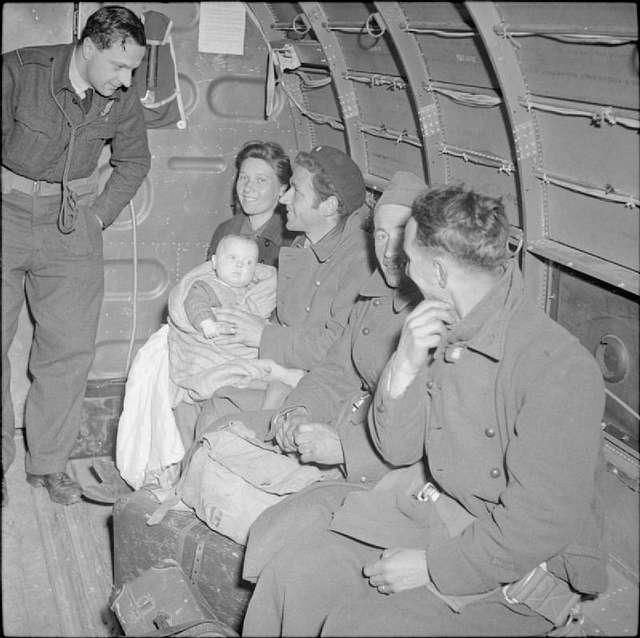
17th April: WO Wood was in command of KG437, loaded with 5175 lbs of petrol bound for B118/ Celle. Five stretcher and seventeen walking wounded were transferred to Brussels Evere before another 175 lbs of petrol was collected and shipped to Celle. The next sector was flown empty, back to Brussels Evere to collect another load of fuel for Celle. Another empty sector was flown to R16/ Hildesheim, again newly-liberated. Twenty-two ex-POWs were uplifted for the flight back to B56/ Evere. A positioning flight was then made to B100/ Goch to collect ammunition destined for B114/ Diepholz. The Dakotas flew empty to R16/ Hildesheim, a further group of ex-POWs was picked-up anf conveyed to RAF Wing before KG437 finally returned to Blakehill.
19th April: Flt.Lt Bentley commanded KG437 on another epic 7-aircraft mission to the Continent. The Allies were advancing far into Germany in the final weeks of the war and Advanced Landing Grounds visited were B118/ Celle, B114/ Diepholz, B122 (unknown) and B150/ Hustedt with petrol and passengers on board. Ex-POWs were transported from Celle and Diepholz back to Brussels and RAF Oakley.
20th April: WO Wood flew KG437 from Blakehill to B150/ Hustedt with petrol before heading to B100/ Goch to collect ammunition for B114/ Diepholz. Finally, 30 ex-POWs were flown from Diepholz to Wing and the Dakota returned to Blakehill empty.
25th April: KG437 delivered petrol to B114/ Diepholz before returning to Wing with ex-POWs.
26th April: Flt.Lt.Bentley was in command of KG437 as one of six Dakotas taking petrol to Celle, continuing to B114/ Diepholz to collect ex-POWs and casualties bound for B56/ Brussels Evere. The next leg took kerosene to B152/ Fassberg followed by an empty sector to B108/ Rheine where French ex-POWs were uplifted for travel to Brussels.
27th April: Bad weather interfered with the scheduled delivery of fuel and the petrol was offloaded at B114/ Diepholz. Ex-POWs were returned to RAF Wing.
28th April: Flt.Lt Bentley took KG437 to Croydon to collect passengers bound for Europe. The return flight was to Netheravon with parachutes.
Logistics flights continued throughout May 1945 as the War drew to a close. On 2nd May FO Hall flew KG437 on a petrol-delivery flight to B118/ Celle. The Dakota proceeded to R31/ Merseburg (?) to collect 30 ex-POWs bound for, firstly, B56/ Evere and then RAF Wing. On May 8th, the day the War ended, KG437, piloted by WO Neal took petrol to B56/ Evere before routing north to newly-liberated Copenhagen. From there, an empty leg was flown to B156/ Luneburg and ex-POWs were embarked for the flight back to Dunsfold.
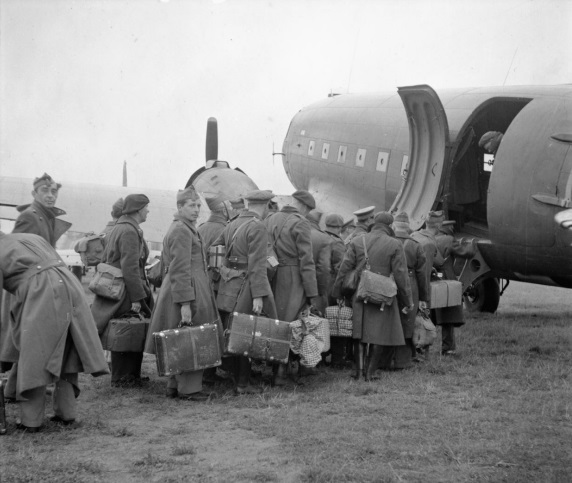
The end of WW2 brought an interesting mission for KG437, ‘FB’ for Freddie Baker as she was known by her crew, and Flt.Lt Bentley.On May 12th, 233 Squadron allocated the Dakota to assist the Supreme Headquarters Allied Expeditionary Forces (SHAEF) on a 10-day detachment to the Continent. They were to assist with personnel transfers during the assumption of command in Germany by allied forces. Their first port of call was General Eisenhower’s base at Rheims to collect Group Captain McComb, an Air Commodore and Brigadier Baltington-Smith. Upon take-off, the Dakota headed for Flensburg in north-west Germany, the naval base where Admiral Doenitz had set-up his ‘Third Reich’ headquarters. En route, KG437 detoured slightly to observe the damage which had been sustained by the Ruhr before landing at Flensburg to drop-off the Brigadier. While on the ground, KG437’s flight plan onwards to Copenhagen was modified when the Dakota was commandeered by none other than Major General Lowell Rooks, Deputy Chief of SHAEF’s G3 Division and the US Officer charged with administering the capitulation of the Flensburg German ‘Government’. Rooks had arrived at Flensburg from Rheims that same day with his British deputy, Brigadier E.J.Foord and a team of 13 Americans and 10 British. The General had been tasked with establishing a control party to impose the allies will on German army personnel contained in the area occupied by the Western Allies. On the afternoon of 12th May he needed to travel from Flensburg to the HQ of 21st Army Group and ‘Freddie Baker’ was the ideal means of transport. The log entry suggests that the airfield closest to the HQ was B102/ Vorst and this seems possible given the two-hour flight duration – too long for the short hop to Montgomery’s HQ at Luneburg. Following a night at what Flt Lt Bentley describes as the ‘Holy of Holies’, Army Group HQ, KG437 returned to Flensburg on 13th May carrying the General and a couple of other allied officers. The crew were then able to fulfill the previous day’s mission of transporting the Brigadier to Copenhagen. Upon landing at Kastrup, they were marshaled to the parking area by German troops and were generally surprised at the number of Wehrmacht soldiers on the airfield – albeit under the control of the RAF Regiment. On the afternoon of May 13th the Dakota returned to Flensburg.
General Rooks had his first meeting with Admiral Doenitz on May 13th and one of his first commands was to have Field Marshall Keitel removed from his post as senior army officer and arrested for war crimes. Keitel, one of the officers who had signed the May 8th surrender documents in Berlin, was due to be transported to the American’s Camp Ashcan, near Mondorf-les-Bains, for internment. However, the dedicated aircraft had not arrived as per schedule and, for a time, it looked as if KG437 would make the flight. However, the stipulated aircraft eventually arrived and the ‘Freddie Baker’ crew missed-out on obtaining the baggage tags with Keitel’s signature. In fact, the Allied Command was constantly having to prevent USAAF aircrews from obtaining the signatures of the senior German Field Staff – after all, most of these men were criminals, not celebrities.
While the crew of KG437 awaited their next mission, General Rooks personally looked after their welfare by arranging accommodation on the ex-Hamburg-America liner ‘Patria’ (2) which had been moored alongside the Flensburg Marine School jetty during the war. Originally used as accommodation for Admiralty officer cadets, Patria had been commandeered by the US Forces which gave the added benefit that the food was of excellent American quality.
(2) The Patria had a long and interesting history. Built in Hamburg in 1938 for an Atlantic crossing trade that was soon to dry-up, she spent most of the war moored at Flensburg. Following use by the Allies during capitulation talks, she was subsequently refitted as a troop ship by Harland & Wolf in Belfast and renamed the Empire Welland. Officially awarded to Britain by the Prize Court in 1946 she was, nonetheless, transferred to the USSR and, named Rossia, she plied the Black Sea for many years. She was sold in 1985 and renamed ‘Aniva’ for a one-way journey to a breakers yard in Kure, Japan.
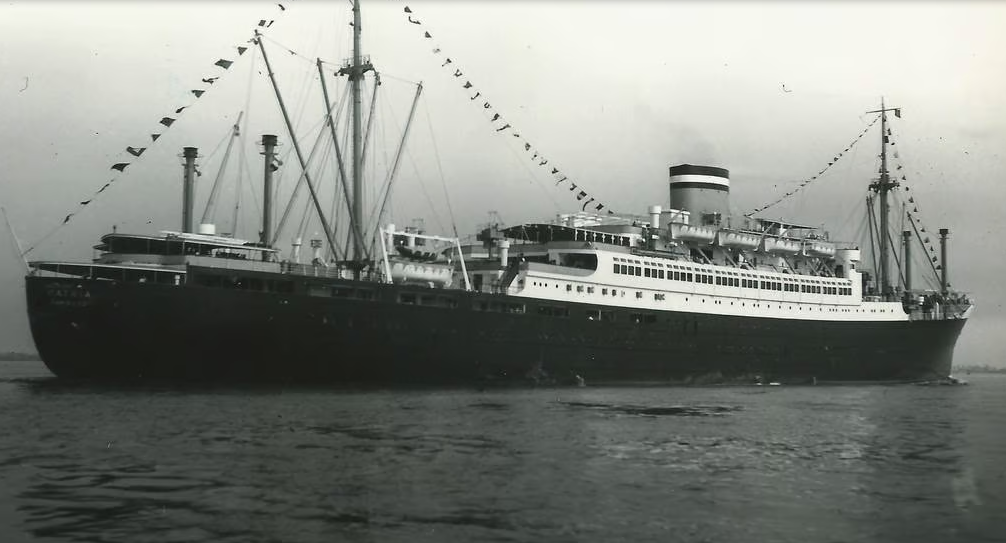
Flt. Lt. Bentley’s crew flew KG437 from Flensburg to Rheims on May 15th, 18th and 19th May delivering allied personnel and some German prisoners to SHAEF control. High priority rations and supplies were carried on return sectors. Missions could be varied at a moments notice and, on May 20th, KG437 made the usual Flensburg to Rheims flight before continuing to Versailles and then Brussels. Upon take-off from Brussels at 21:05, the Dakota was recalled and remained overnight at the Belgian capital. Returning to Flensburg on 21st, the Dakota was on standby until May 23rd. Flt.Lt Bentley commented that he found Flensburg to be rather intimidating for the very limited number of allied personnel accommodated there in May 1945. The local population was understandably reticent and the Nazi Government continued to apply some control from their Glucksburg Castle despite capitulation. A Russian delegation arrived on May 17th which made allied coordination easier and the decision was made to arrest the Donitz government personnel after first luring them to the liner Patria from Glucksburg. To the disappointment of the ‘Freddie Baker’ crew, they missed this historic moment as they had been dispatched to Salzburg to collect a number of interned German Colonels. At 09:45 on May 23rd, Donitz’s key personnel duly reported to ‘Patria’ and, while they were there, allied tank crews, infantry and marines occupied the Glucksburg Castle enclave and the Flensburg Sports and Marine School buildings. General Rooks and Brigadier Foord informed Donitz, Jodl and von Friedeburg that they were now under arrest as Prisoners of War and would be flown into custody at Mondorf-les-Bains in Luxembourg later the same day. Meanwhile, KG437 had flown south through horrible weather before breaking-out into clear blue skies over the Alps prior ti the descent into Salzburg. The Dakota was back in Flensburg the same evening after an intermediate stop (possibly at Nuremburg). Copenhagen was on the flight plan again for May 24th with an afternoon flight and overnight stay in the Danish capital. After returning to Flensburg on May 25th, the Dakota headed south to Rheims and, subsequently, Paris Le Bourget. May 26th saw KG437 returning to Flensburg, again via Rheims. On May 27th, the Dakota made the final flights of her secondment, taking Major General Rooks to Frankfurt before routing to Le Bourget and then to Blakehill Farm. Flt.Lt Bentley seems to have been impressed with the consideration and politeness of General Rooks, his staff and the personnel at SHAEF and hoped to return to the operation later in the month (3). However, this didn’t happen and KG437 was back hauling freight on May 28th in the hands of Pilot Officer Barry Stableford. An empty sector to B56/ Brussels Evere was followed by a cargo for B154/ Reinsehlen then an empty leg to B156/ Luneburg to collect three Displaced Persons destined for B56/ Brussels. Finally, thirty ex-POWs were returned to Dunsfold.
(3) KG437 and her crew’s adventures are taken from 233 Squadron records with supplementary information on the ‘Flensburg Government’ from ‘After the Battle #28’.
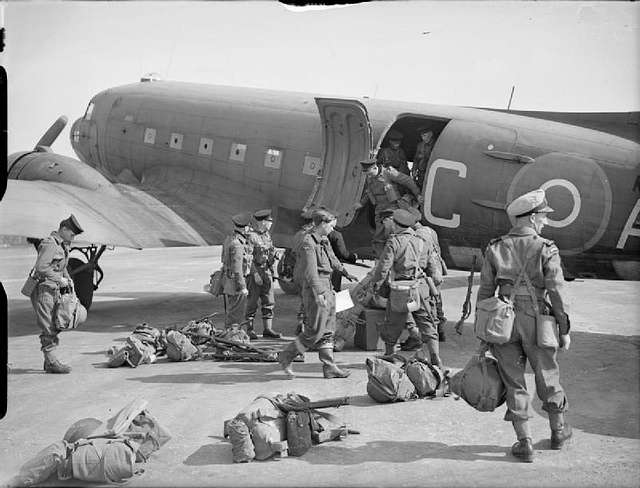
For KG437, June 1945 started with a flight to Fairwood Common on 3rd as part of a 14-aircraft mission transferring the personnel and kit of 266 Squadron to B11/ Ahlhorn, near Bremen. 266 was a Rhodesian-manned Typhoon squadron. WO Neal then continued to B109/ Quakenbruck with the rest of 233 Sqdn Dakotas. KG437 then returned to Blakehill with 27 passengers. The following day, Flt.Lt Craven was in command for a flight transferring 17 passengers from Blakehill to Fairwood Common and the 15 passengers and kit onwards to B113/ Varrelbusch as part of a 10-aircraft mission. Positioning empty to B115/ Melle, 27 passengers were collected for return to Fairwood Common. On June 6th KG437 made its last take-off from Blakehill as a base, collected 18 passengers from Croydon and flew to B111/ Ahlhorn before continuing to B118/ Celle with six passengers and freight. The next sector was to B61/ Sint-Denijs with eleven passengers and freight. PO Wright then returned to Odiham, 233’s new base, on the morning of June 8th.
June 11th saw FO Hall taking KG437 empty to Croydon to collect 23 passengers destined for Brussels-Melsbroek. Hopping empty to B56/ Brussels-Evere, the Dakota collected freight bound for Down Ampney and then returned to Odiham. 17th June involved PO Wright and KG437 on a similar mission: flying empty to Croydon to embark 21 passengers bound for Oslo. From Norway, the aircraft flew empty to B156/ Luneburg in order to collect 24 Displaced Persons bound for Brussels Evere. During May and June 1945 SHAEF repatriated an amazing 5.25 million Displaced Persons (4) at a rate of 80,000/ day. Clearly, many of these will have been traveling on Europe’s compromised rail network.
June 18th 1945: Flt.Lt Bentley’s crew were back in KG437 for an 07:50 lift to Ibsley where 4500 lbs of freight was embarked for Oslo. The return from the Norwegian capital was flown empty. After a 5-day break, it was Flt.Lt Bentley at the controls again on June 23rd for an empty sector to Croydon followed by the transport of 4000 lbs of freight to B116/ Wunstorf. One passenger was flown onwards to B56/ Evere and 25 DPs uplifted for B156/ Luneburg. The return flight to the UK (Warmwell?) carried 16 passengers. On June 24th Flt.Lt Moulder flew KG437 empty to Lyneham to pick-up 3375 lbs of RAF stores bound for B150/ Hustedt. Flt.Lt Bentley was at the controls again on 25th for an 07:30 lift heading empty to B58/ Brussels Melsbroek. Twenty ex-POWs were returned to RAF Ford and then the Dakota flew to B56/ Evere to collect 15 French passengers bound for Croydon. KG437 returned to Odiham before a very similar operation the following day: Flt.Lt Bentley in command, empty to Croydon, 11 passengers to B56/ Evere, 25 passengers to B116/ Wunstorf before heading back to Odiham empty. FO A.Cheshire was in command for a 2-day operation spanning 28th and 29th June 1945. After an empty sector to Ibsley, a 4639 lb cargo (freight plus 2 passengers) was loaded for transfer to Oslo and then onward to Trondheim in Northern Norway. On 29yh, KG437 flew to Bardufoss and then back to Oslo empty. In the Norwegian capital they boarded 19 French ‘professional’ ladies who had been kidnapped by the Nazis and were now being repatriated to Paris.
(4) IWM data.
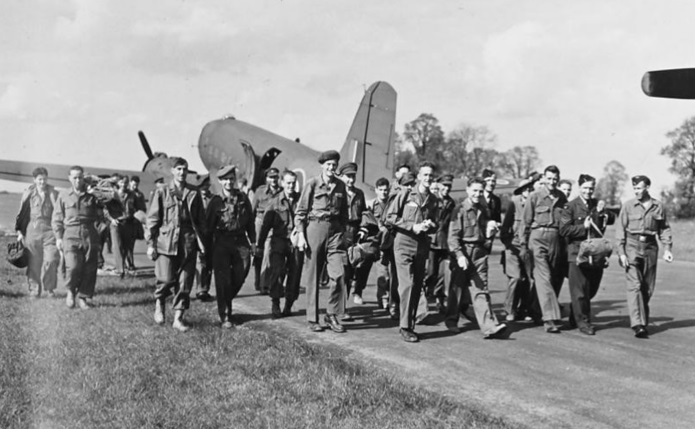
Record keeping in July 1945 was somewhat erratic prior to the Squadron’s departure for India. KG437 appears to be recorded as ‘UW’/ Uncle William for the July 1st flight by FO Cheshire’s crew. 5000 lbs of freight and three passengers were delivered to B168/Hamburg before the Dakota flew on empty to B113/ Varrelbusch, collected 18 casualties and returned to B56/ Brussels Evere before returning to base empty. On July 2nd FO Williams crew flew KG437 empty to Northolt in order to collect passengers for Y74/ Frankfurt. Eighteen passengers were carried to Northolt on the return. July 3rd saw Sqdn Ldr Daniel taking 12 passengers and their kit to Broadwell, returning to Odiham with 7 passengers. FO Alford is then reported as taking PO McAllister and crew from Odiham to Blakehill Farm.
FO Menzies in KG437 lifted at 06:55 on July 5th bound for Ibsley to collect equipment for Berlin Gatow. The return was made via B116/ Wunstorf in order to pick-up 21 passengers bound for Lyneham (5). the next day, July 6th, FO Green’s crew traveled to Boreham as part of a multi-aircraft lift to deliver 107 displaced persons to Oslo Fornebu. Again, the Dakota flew on north to Bardufoss with 17 passengers and then to trondheim with 2 passengers. On July 7th the return flight to Oslo was empty but continued to Brussels Evere with 24 passengers. The sector home to Odiham was flown empty. Record keeping in mid July is, again, erratic but KG437 ‘UW’ is noted as flying empty to Northolt on July 9th. FO Alford then continued to Gatow with 5016 lbs of freight before returning to Odiham for a 20:40 touch-down. On July 10th Flt.Lt Priestley flew a circuit from Odiham to Northolt and back, empty, in ‘UW 437’. By the time KG437 departed for India, she was recorded as ‘UD’. This may mean that some additional flights were operated by KG437 where the Dakota is recorded as ‘UD’. However, where ‘UW437’ and ‘UD437’ overlap, there are clearly errors.
July 10th: ‘UD437’ piloted by FO Neal, flew to Boreham in Essex to collect freight for Oslo. The Dakota continued from Fornebu to Bardufoss and transferred one passenger to trondheim. The return leg to Oslo carried 14 passengers. The next sector carried 24 Displaced Persons to B56/ Brussels before the Dakota returned empty to Odiham.
July 12th: ‘UD437’ flown by Flt.Lt Priestley flew signals equipment to Gatow before transiting to B168/ Hamburg to collect a Marine band destined for Berlin Gatow. The Dakota then returned to Northolt with three passengers and mail.
July 13th: ‘UD437’ flown by PO Morrison positioned to Northolt to collect 24 passengers bound for SHAEF headquarters via R14/ Detmold. Continuing empty to Y56/ Monchen Gladbach, the aircraft picked-up 25 passengers for A54/ Paris Le Bourget before returning to Odiham.
Training for operations in India commenced on July 16th and WO Lee is recorded as flying 437 on 17th July. By 19th, PO Purley was practicing parachute dropping in KG437 and, during the afternoon, Flt.Sgt Mason repeated the exercise. Formation flying was practiced by ‘UW’ on July 21st.
(5) Confusingly, the entry in the records is for ‘KN437’ but that Dakota didn’t operate in the European theatre. However, KG437 is recorded as being air-tested by Flt.Lt Moulder with a 14:55 take-off bound for Croydon, Wroughton and Blakehill, so perhaps the Berlin flight was another Dakota.
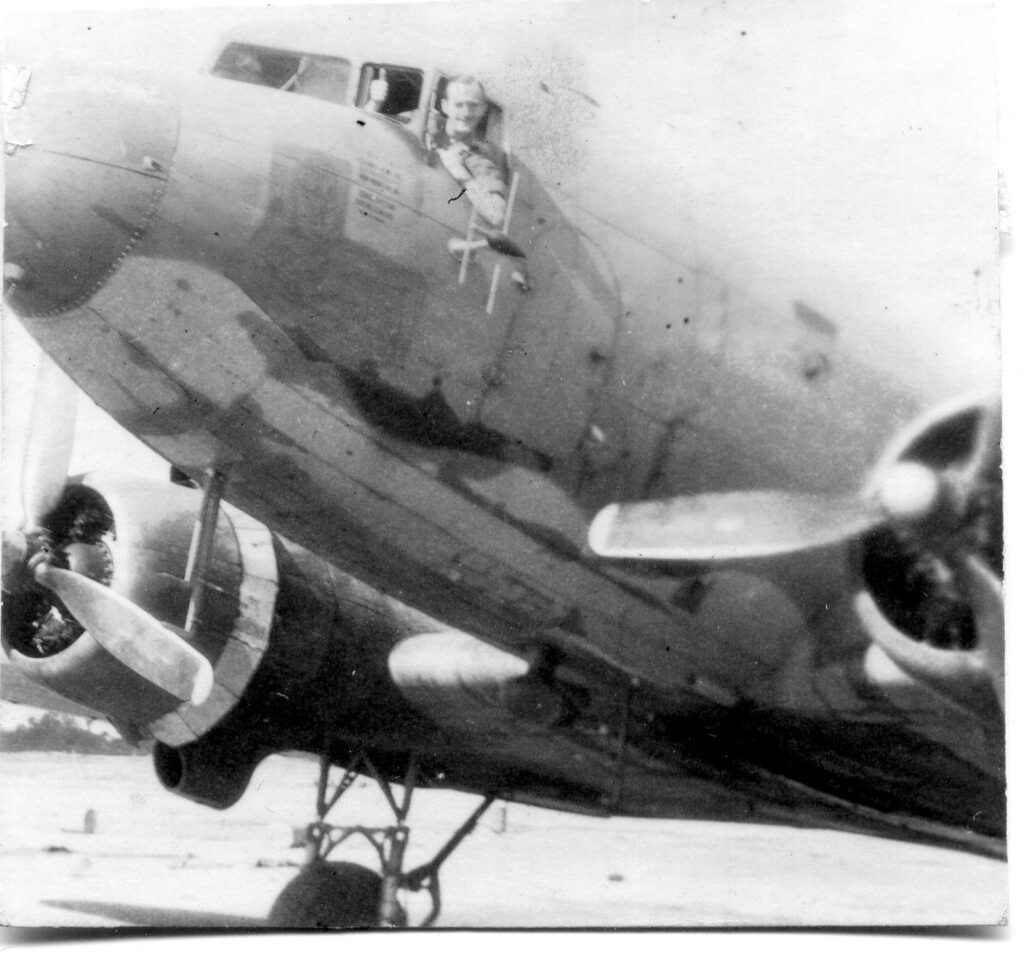
After an air test from Odiham on August 13th, a crew headed by Flt.Lt Parks departed the UK for India on August 15th 1945. Part of the first wave of five 233 Squadron Dakotas heading for Tulihal, KG437 is logged as taking 5 hours and 45 minutes to fly the first stage to Elmas in Sardinia. FO Holmes, the navigator, recorded the next sector to El Hadem/ Tobruk as taking 5 hours and 40 minutes on August 16th. From there, it was 3 hours 55 minutes to Lydda, Palestine, on 17th and 3 hours 5 minutes onwards to Habbaniya, Iraq the following day. The next stage to Sharjah was flown on August 20th by day (2hr-55) and night (3hr-00) possibly to avoid excessive heat. The next leg to Karachi/ Drigh Road was also commenced on August 20th and took 5 hours 5 minutes. Now on the Indian sub-continent, KG437 flew to Bamrauli/ Allahabad on August 23rd and finally to Tulihal, Imphal, India, on August 24th.
An initial operational flight was made on 26th August when Flt.Lt Fisher completed a 3 hour round trip from Tulihal to Bhamo in Burma. KG437 flew one further operation in India, flying to Myitkyina and back from Tulihal before (probably) returning to the UK with 435/ 436 Squadrons RCAF. KG437 is reported as being assigned to a Canadian squadron on 5th September 1945 by which time she was probably back in the UK at their new home of Down Ampney. After probably serving with 436 Squadron RCAF during Autumn 1945, she is recorded as moving to 437 Squadron during December. This was probably just an interim measure and her use on regular operations is not recorded prior to her demobilisation to BOAC in January 1946.
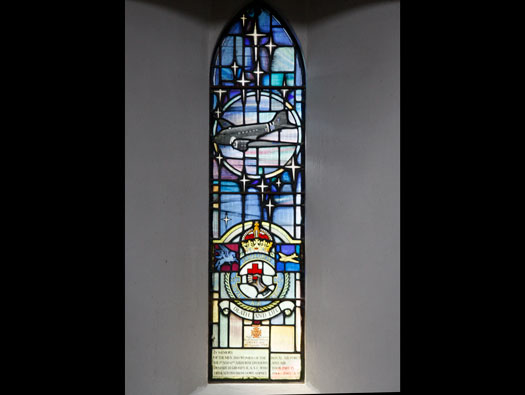
Civil Career:
KG437 was unusual in that, as part of the first wave of 233 Squadron Dakotas heading for India, she arrived in time to fly a couple of missions within India/ Burma. Operations were flown to Bhamo on August 26th, Myitkyina on 27th but she was soon on her way back to Britain with the RCAF Squadrons being replaced by 233 Squadron. Officially allocated to 436 (possibly 435) Squadron, KG437 operated general transport services around the UK and Europe. On 6th October 1945, she is reported as being delivered to Marshalls of Cambridge for repairs which were completed by December 18th. Recorded as transferred to 437 Squadron RCAF in December 1945, there is little sign of her having operated with them and the overhaul by Marshalls may indicate that she was already destined for ‘Civvie Street’ with BOAC. Certainly, when 437 Squadron returned to Canada KG437 wasn’t part of the armada and was officially demobbed on 8th February 1946. By then, she had been transferred to BOAC, reportedly at Whitchurch (2), on 15th January 1946 and probably followed much the same career path with the national airline as G-AGYZ. She was issued with a CofA on March 21st 1946.
BOAC had been created at the start of WW2 by the amalgamation of Imperial Airways and the, then, private company British Airways. Imperial also had a stake in the British domestic airline market via Railway Air Services, a company created along with the four large private rail operators. The election of a Labour government in the UK in July 1945 paved the way for airline nationalisation in August 1946. Railway Air Services (and the other 20 or so civilian operators which had been amalgamated into the wartime Associated Airways Joint Committee) were to become British European Airways as from 31st January 1947. In the interim, the AAJC airlines continued to operate services on behalf of BEA and received around 24 Dakotas from BOAC. A lack of spares meant that up to 25% of this fleet could be grounded at any one time while the remainder operated on key routes such as the London to Glasgow service. G-AGYX is recorded (1) as being allocated to BEA as from 19th August 1946 and will probably have operated on passenger routes with a 20-seater configuration.
On January 31st 1947, BEA formally took over all aircraft, routes and staff of Railway Air Services and the other AAJC airlines. G-AGYX will have operated in an all-metal finish and the full BEA titles and ‘speed key’ symbol will have been applied.
(1) Background history from Air Britain publication ‘DC-1/ DC-2/ DC-3- the first seventy years’ by Jennifer Gradidge.
(2) From CAA website G-INFO.
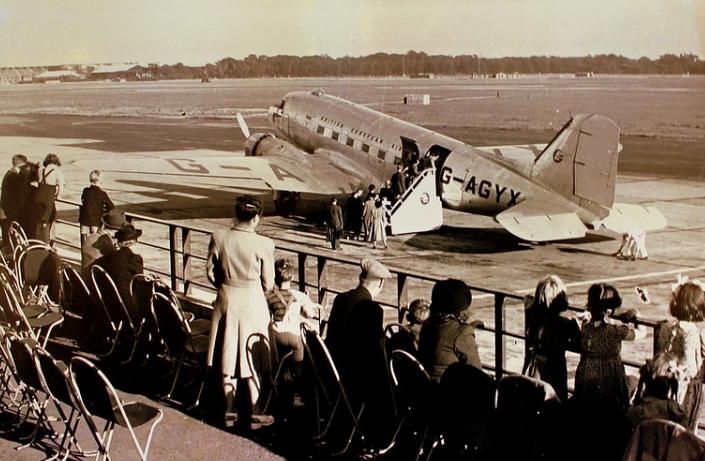
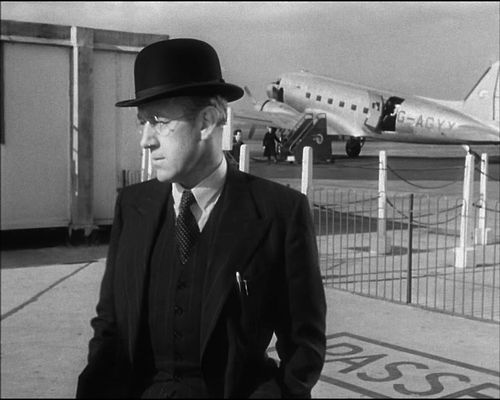
The 1951 Ealing Studios movie ‘The Lavender Hill Mob’ featured a shot of G-AGYX in the natural metal BEA scheme, probably filmed at Northolt as a substitute for Paris. By the summer of 1951, G-AGYX had been repainted in the new ‘Pionair’ colours with a white fuselage top, three red cheat lines and the Union flag on the tail. The actual Pionair conversion is not believed to have taken place until 1952. The fleet name ‘George Holt-Thomas’ was bestowed upon her as part of this Scottish Aviation upgrade of the BEA fleet to 32-seat Pionair status. The conversion work on G-AGYX was carried-out at Prestwick between March 25th and May 5th 1952 before the aircraft was returned to BEA at Glasgow Renfrew.
G-AGYX was back on the silver screen again in 1954 for the Francis Durbridge espionage thriller ‘The Teckman Mystery’ which cast the BEA Dakota as herself in scenes filmed at Northolt. The Dakota continued to work in passenger mode and was with BEA for over thirteen years.
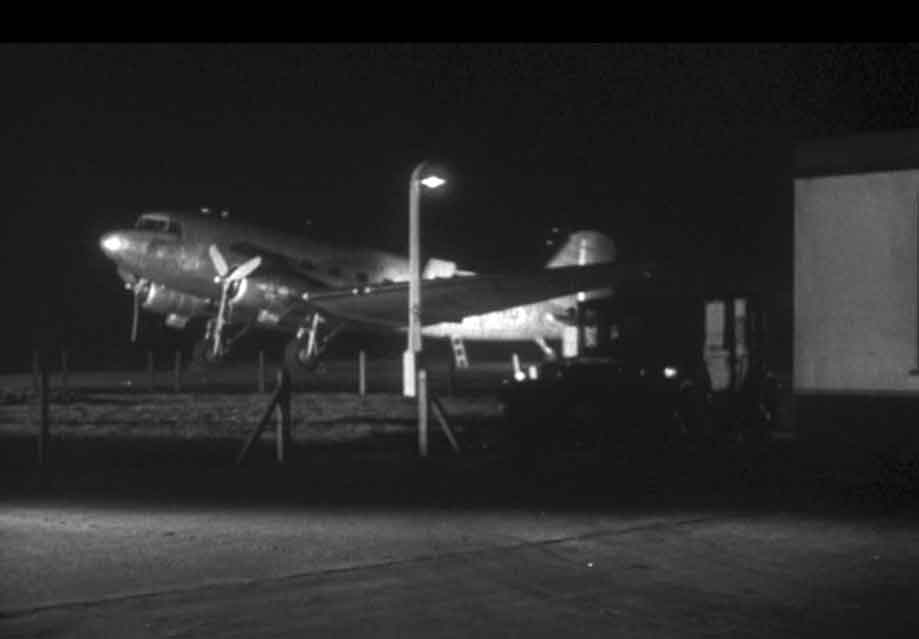
On March 29th 1961, G-AGYX was flown to Field Aircraft Services at Wymeswold in preparation for sale to Autair (Luton), a worldwide helicopter operator which was diversifying into airline operations (3). Delivered to Autair at Luton on 21st April 1961 and registered to them six days later, the Dakota was ready for the 1961 summer season and the airline operated some of its own Inclusive Tours. Otherwise, the Dakotas operated on lease to other airlines and, for the spring and summer of 1961, G-AGYX operated Skyways Coach Air services from Lympne to Beauvais in full Skyways of London colours. Indeed, the Dakota appears to have retained its basic Skyways scheme when it returned to Autair and still had the turquoise cheat line with red trim even when sold to its next owner, Libyan Aviation.
Libyan Aviation purchased G-AGYX on 12th February 1962 in the name of C.J.Bicknell. The company had been formed in July 1960 with a DH Dove to operate on-demand charter flights in support of the oil industry in Libya. British crews flew British-registered aircraft and G-AGYX passed through Malta on 16th February on delivery to her new owners.
By 1962, the management structure of the organisation was complicated: a British company, Metropolitan Air Movements, provided operational, technical and mechanical support to Libyan Aviation and another wholly-owned subsidiary, Aero Exploration Ltd. The Managing Director of Metropolitan, Captain Brian Pocock, was also MD of Libyan Aviation and, in their LAVCO phase at least, flew for a time as their chief pilot (4). Several of the aircraft were registered to B.L.R.Pocock and, on 22nd May 1962, G-AGYX was transferred to his name. The Chairman of Libyan Aviation was Abdul Mejid Bujazia and the General Manager was C.H.J.Bos. Their customers were mainly the oil companies operating in Libya and, further south, in Niger. The Doves and Dakotas were flown from the Benghazi base to various desert air strips. J.W.Beazley was also involved with the operation as well as being the prime mover behind both Air Libya and United Libyan Airlines. G-AGYX swapped ownership from Brian Pocock to J.W.Beazley on 17th January 1963, the new owner registering his home address as Mallorca. The companies involving John Beazley also operated some scheduled services and a 1963 route was established between Tripoli and Niger to feed into charter services operating to further-flung oilfield destinations. (5) (6). The Libyan companies suffered from nationalisation issues and, eventually, morphed into LAVCO which carried-out much of its work from Malta. However, G-AGYX left North Africa for the time being in 1965, heading back to Britain to be sold by Shackleton Aviation.
(4) B.L.R.Pocock had been working for BP when they first struck oil in Libya.
(5) Encyclopedia of African Airlines by Ben Guttery
(6) British Independent Airlines 1946-1976 by Tony Merton-Jones.
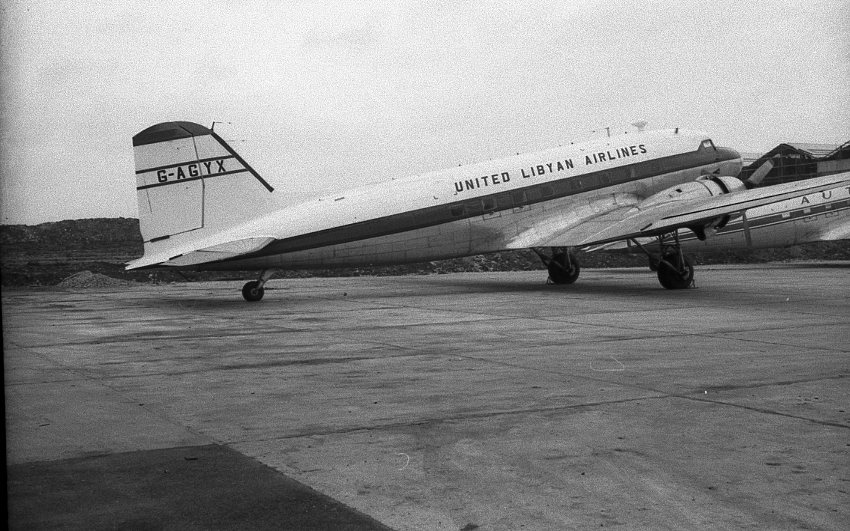
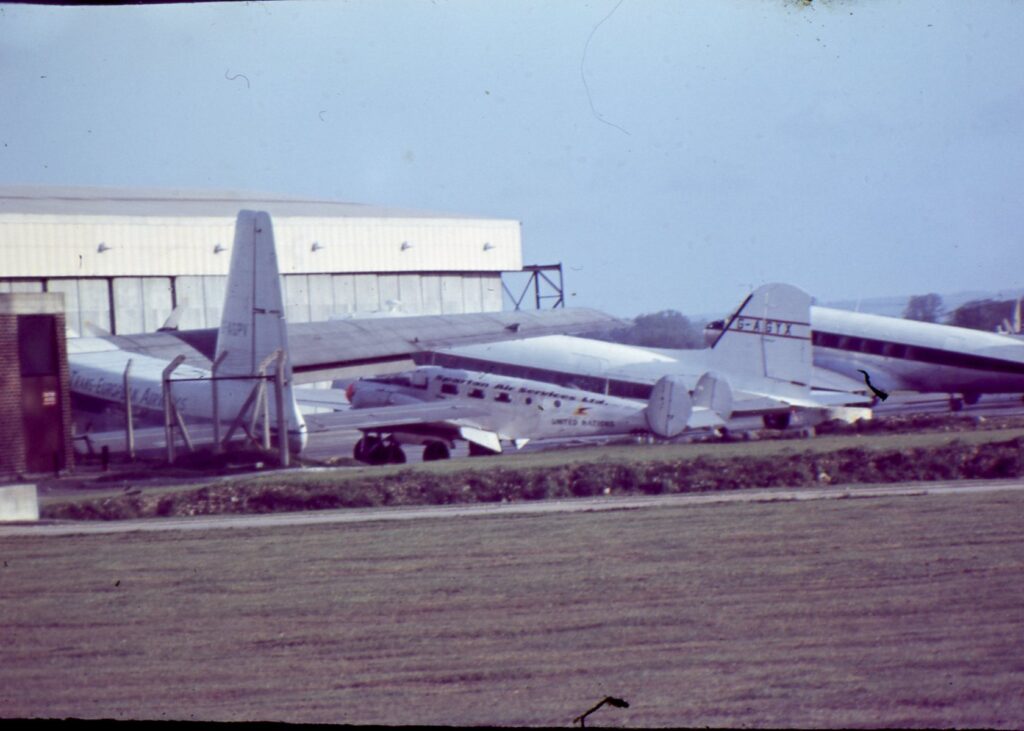
As an aside, Captain Pocock and Metropolitan seem initially to have decided to use any capital rescued from Libya to fund a British-based operation. Metropolitan bought out the struggling British Westpoint on September 13th 1965 and, as they had in Libya, assumed the role of holding company while Westpoint operated the services (see history of G-ALYF). This soon proved to be non-viable and Westpoint went into liquidation in May 1966, Metropolitan ceasing flying services the following year. Libyan Aviation also had financial problems in late 1966 and briefly reformed under the title Explorair. Eventually, branded as LAVCO, the operation continued to support oil industry operations flying largely US-registered C-47s from Benghazi and Hal Far, Malta. Their other ex-Autair Dakotas, G-AJIC and G-AGHJ, suffered owing to the airline’s financial problems. G-AJIC had benefited from a major overhaul in Beirut in 1966 but the work hadn’t been fully paid-for and G-AGHJ was seized in lieu of payments. Despite being in relatively good condition, G-AJIC remained derelict at Benina during 1969, her CofA having expired on 24th August 1966. Captain Pocock was reportedly the Chief Pilot at LAVCO between 1966 and 1968 and later joined Hugh Kennard, an old friend, at Invicta Airlines at Manston flying as a DC-4 Captain before moving to British Air Ferries at Southend. His next project involved another Dakota/ Dove operation in West Africa: Cameroon Air Transport. The company had been formed in 1965 by the Cameroon Development Corporation and, in 1968, leased the ex-British Midland Dakota G-ANTD (registered TJ-ACF). Captain Pocock flew the Dakota to West Africa with his wife, young child, an engineer and a spares complement. The Dakota was based at Tico and the family is reputed to have actually lived in the aircraft between flights within West Africa during 1969 when Brian Pocock was the airline’s Chief Pilot. By August 1970 G-ANTD , Teardrop, had returned to the British register with Field’s Aircraft Services and Captain Pocock had moved on to work spells with Nigerian Airways in Lagos and with British Aerospace in Mallorca and Tenerife. During the 1980s he moved to Southern Africa as the general manager of Air Malawi and, subsequently, Air Botswana. His tenure at the Botswana state airline was between 1989 and 1994 and ended with a warrant for his arrest being issued by the country’s Directorate on Corruption and Economic Crime following alleged irregularities. The two-year investigation was hampered by the fact that Brian Pocock had moved on to become Chief Executive of Barbados-based Carib Express in 1995 (7). Local investment and British Airways participation failed to make the airline a success and it folded in 1996. Consultancy work for Richard Branson at Virgin took him to Kazakhstan and China before he retired to Mallorca in the 2010s. In 2011 he reported that he had flown 27 aircraft types, formed three airlines, managed four and was still working at 75 (8). He died on August 5th 2019, aged 83.
(7) From www.flightglobal.com
(8) Biographical and other information from www.ruudleeuw and www.oldruymians.co.uk.
G-AGYX arrived at Shackleton Aviation on 10th June 1965 but didn’t stay long. On 29th June, she was delivered from Gatwick to her new owners, Martin’s Air Charter, in Amsterdam, still registered G-AGYX. The Dutch organisation had grown from a banner-towing business formed by Martin Schroder in the 1950s to an air taxi and sightseeing company operating DH Doves during the early 1960s. The de Havilland aircraft proved a little too small and Martin’s occasionally leased KLM DC-3s before buying their own examples, PH-MAB (from Alitalia on 8th Feb 1960) and PH-MAA (ex-BEA’s G-ALXM, added to the fleet July 1st 1960). Martin’s Air Charter continued to expand and, in late 1963/ early 1964, minority shareholdings were acquired by the Holland America Line, Royal Rotterdam Lloyd, the Nederland Steamship Company and Scheepvaart en Steenkolen Maatschappij. The latter also owned fellow Dutch airline Transaero/ Fairways which operated two DC-3s on passenger charters from Rotterdam. The Fairways fleet was combined with Martin’s DC-3s in January 1964 but, by the end of the year, demand meant that the airline had to briefly lease another DC-3 from KLM. The arrival of PH-MAG in July 1965 was therefore a welcome event and, within days, the Dakota was operating a passenger charter from Amsterdam to Southend on August 3rd. The Essex airfield had been a frequent destination for Martin’s since 1960 and Amsterdam to Southend continued to prove a key route for both passengers and freight throughout the mid-1960s.

PH-MAG was a frequent visitor to Southend throughout the summers of 1965, 66 and 1967 and was also noted often at many British airports such as Blackpool and Manchester. By the end of the 1966 summer season, the airline had rebranded as Martinair and the airline was looking to open-up long haul routes with jets. The five Dakotas remained busy until autumn 1967 when the sale of two started the phasing-out of the type. PH-MAG continued to ply routes around the Continent and to the UK in her now-familiar red/ white/ blue livery. The flights to Southend were curtailed in 1968 with PH-MAG’s first appearance at the Essex airfield on April 15th. A handful of similar flights was operated in both June and July, another trip on August 3rd and then her penultimate flight of the season on August 10th. Martinair’s propliner days were drawing to a close with the sale of two of their DC-7Cs to Transmeridian Air Cargo in late 1968 (see the Biafran Airlift thread for PH-DSL) and the departure of PH-MAG to Moormanair Holland on October 2nd 1968 (10).
(10) Martinair Holland information from Fernand van de Plas’s article in Propliner Magazine issues 110 and 112.
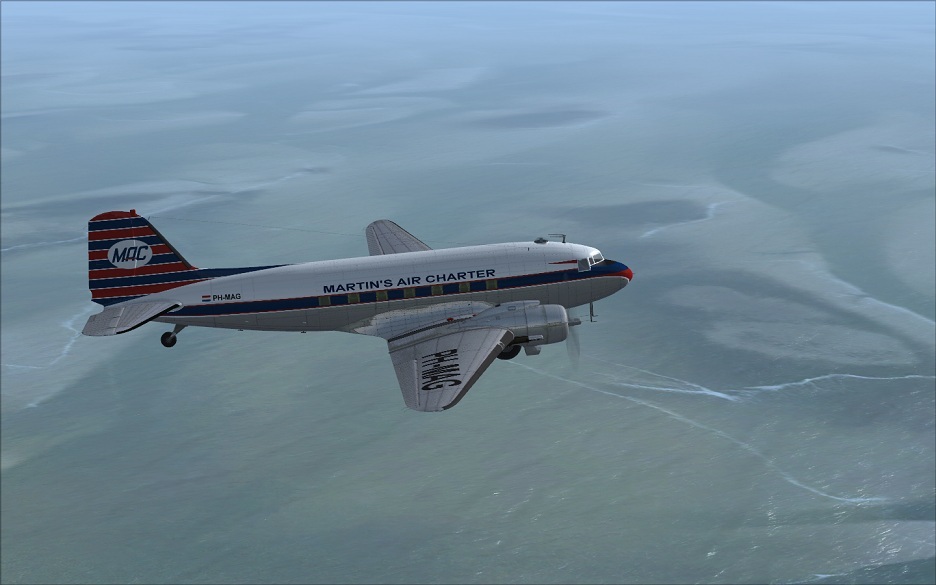
Moormanair had started life in 1967 as an air taxi operation and the arrival of the Dakota proved to be a notable expansion. They also briefly chartered Martinair’s Dakota PH-MAB during 1968 prior to that aircraft’s departure for Australia as part of the back-up team for DAF’s participation in the London to Sydney World Cup rally. Sporting a tidy new blue and white colour scheme, PH-MAG flew frequent cut-flower charters between the Netherlands and Paris. As business grew, Moormanair leased the ex-Luftwaffe C-47 N3179Q from Brian Merrick’s Shannon-based company, Welltrade. Originally due to join the Dutch register as PH-WWW, the second Dakota commenced operations for Moormanair as PH-MOA during 1970.
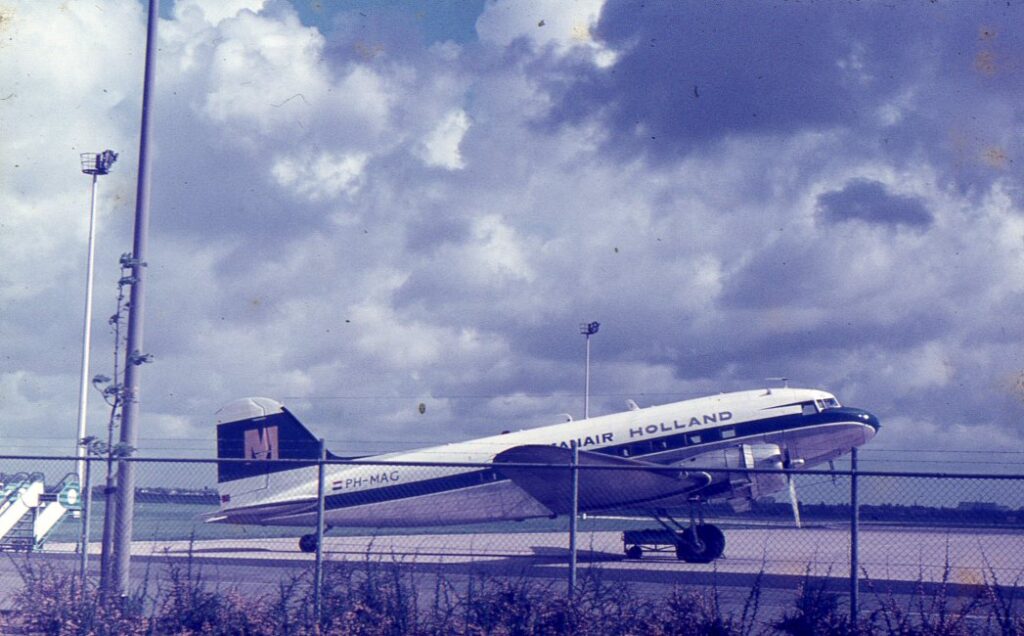
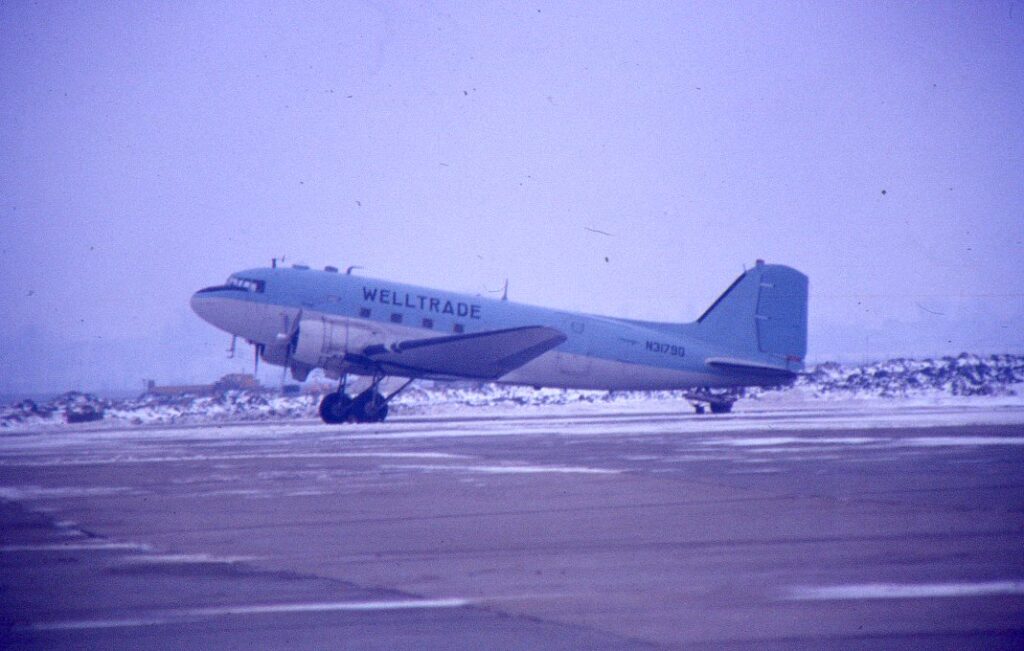
On June 3rd 1971, PH-MOA, flown by Brian Merrick himself, suffered a serious landing accident while landing at Southend carrying Ajax football supporters. Having departed for Amsterdam, the Captain turned back owing to a technical fault with the starboard engine. Faced with the possibility of having to go-around again, the pilot opted to touch down part way up the runway with only 15 degrees of flap selected. The aircraft’s brakes didn’t perform well and the Dakota ran off the end of the runway, colliding with an earth berm. There were no fatalities but PH-MOA never flew again.
PH-MAG continued with mixed operations, often seen in Britain on freight charters. She visited Stansted twice on 17th December 1971 and again on 24th December and 8th January 1972.
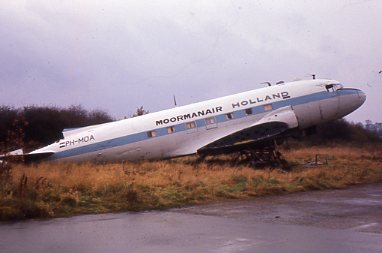
Two Doves were added to Moormanair’s fleet in summer 1972 but PH-MAG had been leased to Antwerp’s Delta Air Transport during 1972. She also operated a flight from the Netherlands to Malta on January 27th 1973. However, Moormanair had financial problems and ceased operations later in 1973. PH-MAG was sold to the movie production company Scorpio Films on May 14th 1973 and went on to appear in the title role of the Wim Verstappen film ‘Dakota’.
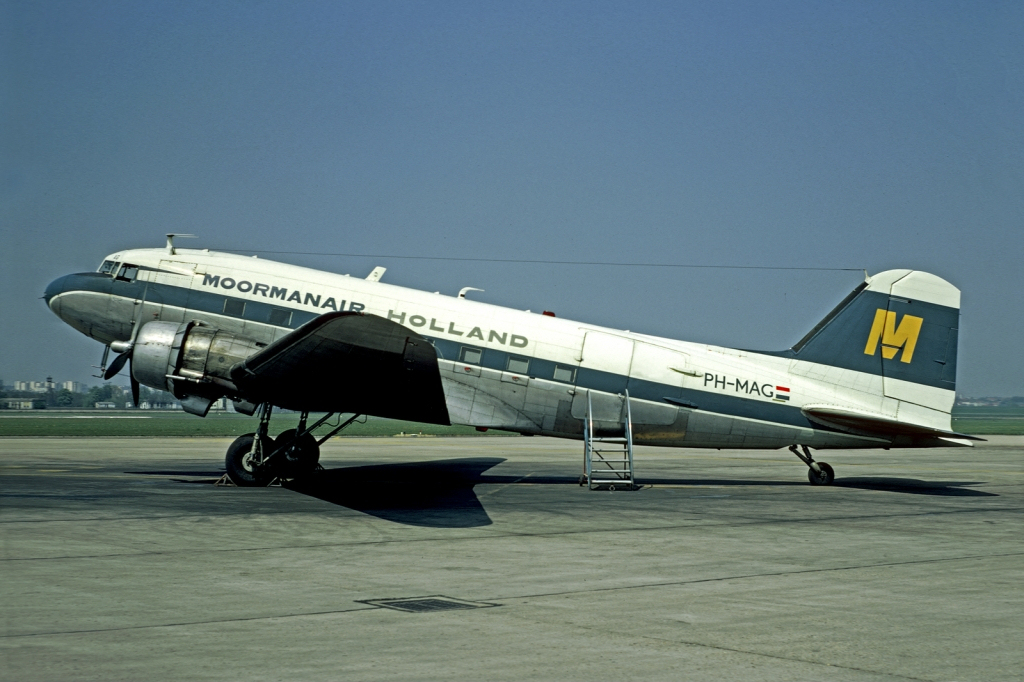
For Scorpio Films, the purchase of PH-MAG was an essential but large expense and a certain amount of maintenance work was required before she embarked on her flight across the Atlantic to the filming location. The preliminary work unfortunately involved a change of colour scheme to the horrible baby-excrement yellow and white livery of the film’s ‘Dakota Airways’.
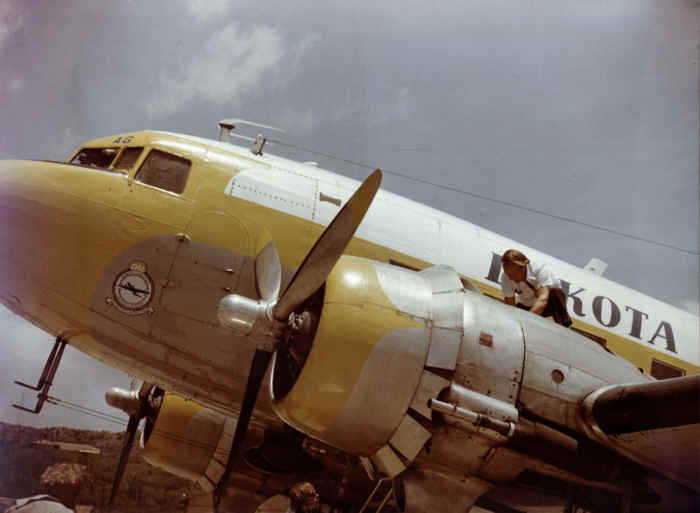
The film was shot partly on location in Curacao, Surinam, where the screenwriter and director Wim Verstappen had grown-up, and partly in Holland. With a limited budget and a large number of ‘creative differences’ during production, the filming of ‘Dakota’ didn’t go smoothly. The three-strong aircrew were joined in Curacao by sixteen technical crew and a cast which included actors Kees Brusse, Willeke van Ammelrooij and Monique van de Ven. The well-regarded cinematographer Jan de Bont was hired to shoot the movie in glorious Eastmancolor but didn’t perform as required and was replaced before the end of filming. Kees, the ‘star’ of the movie, was rumoured to be afraid of flying and, while he was happy filming on the ground at Hato Airport, he didn’t enjoy aerial shots nor the landing on a jungle strip in interior Surinam. A chase plane was employed to film PH-MAG during aerial shots of cargo being jettisoned over Klein Curacao and for a stall scene -from which the old Dakota recovered smoothly – but scheduled flying scenes in Colombia were canceled. At the end of filming, the Dakota was flown home via the classic Ferry Command ‘Northern Route’: Port-au-Prince to Miami to Wilmington to Montreal, Goose Bay, Bluie West One, Keflavik and Prestwick to Amsterdam. En route repairs were carried-out at both Montreal and Keflavik.
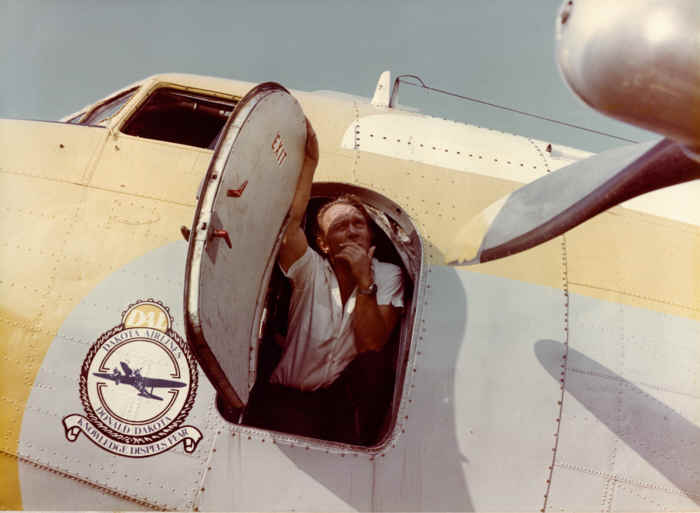
Post location work continued in the Martinair hangar at Schiphol where PH-MAG was surrounded by trestles and stepladders for internal shots. The windows were blanked out to control the lighting and innumerable changes of seating and cargo configurations were enacted. The Dakota was also used for flying scenes into a short grass airstrip on the offshore island of Ameland – a scene which Martinair had visited in the past. PH-MAG was also used by Scorpio Films to fly celebrities and critics to the Cannes Film Festival but PH-MAG didn’t behave well, suffering from magneto issues during a fuel stop in France. The final cut of the movie was issued in 1974 but was not, initially, well-received by Dutch cinema-goers. It has since been re-released following the 2004 death of Wim Verstappen to greater critical acclaim (11).
Scorpio Films were keen to get their expensive prop off the company’s books and, on March 13th, the Dakota was sold to Nigeria Trade Wings as 5N-ATA.
(11) Movie details are from the site www.thelooniverse.com’s article on Scorpio Films ‘Dakota’.
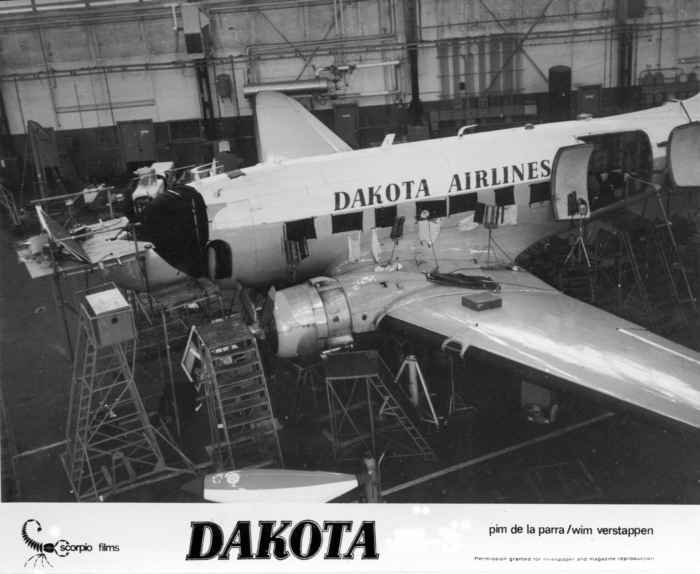
Nigerian Trade Wings had been established on June 3rd 1970 with an office in Yaba, Lagos, and had attempted to buy two ex-Sudan Airways Dakotas from Field Aircraft Services in 1971. Although the aircraft got as far as being painted in a smart green and red Nigerian Trade Wings scheme, it appears that finance was not forthcoming and, eventually, the two aircraft departed to the USA as N6CA and N7CA in Spring 1973 (12). By 1974, Trade Wings bank balance must have improved sufficiently to permit the purchase of PH-MAG in April and also a second Dakota from Ghana. The two aircraft were painted with a blue cheat line and tail fin with a white fuselage top and grey undersides.
(12) G-AMYB was due to become 5N-AJE with Trade Wings but was sold as N6CA and, ten years later in the early 80s, became a ‘white goods contraband runner’ across the US border into Mexico from Mc Allen, Texas. G-AMZS was due to become 5N-AJF but was sold as N7CA and joined the air mail company SMB Stage Lines.
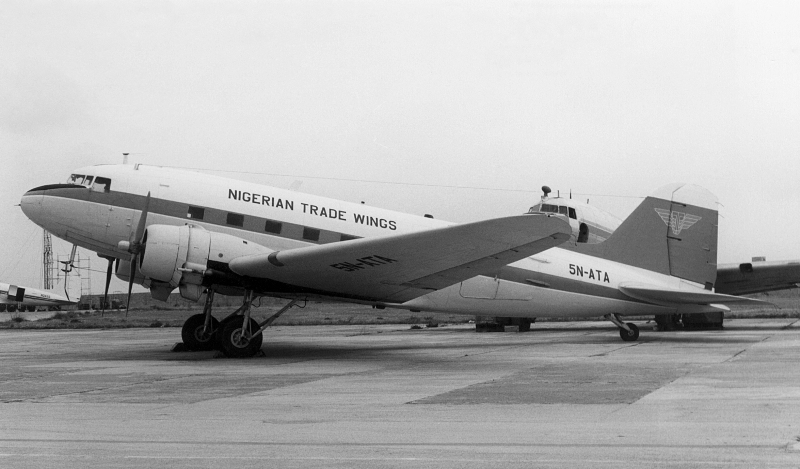
Nigerian Trade Wings (NTW) aircraft seemed to spend a lot of time in Malta, so it seems likely that they worked oil industry contracts in West Africa and the Saharan desert. The Nigerian airline also operated DC-6s 5N-ATD, possibly 5N-ATF, and leased C-118 N92860. When 5N-ATF departed Malta, it was re-registered to the CIA front company Air America. One of NTW’s pilots in the late seventies was one Thomas Henry Sullivan who had previously been the Manager of Flight Operations for Air America in Vientiane, Laos. This could be coincidental, but it may indicate the interests of NTW’s backers. In May 1977, 5N-ATA flew to Malta for overhaul by MIACO. At that time, LAVCO, the contemporary form of G-AGYX’s previous owners, Libyan Aviation, was MIACO’s main customer. The overhaul may have been somewhat protracted as the Dakota was still parked in Malta in December 1977. The next record of 5N-ATA is a lease to U.L.Drew in May 1978 (13). The Dakota was supposedly sold to Lease Air Inc of Florida as N9050T on 29th January 1979 but she was noted in Sudan later that year, still as 5N-ATA and with Trade Wings titles. Recorded as being ‘semi derelict’ in Khartoum in 1980, the ownership of the Dakota was, nonetheless, recorded as passing to Autair (Malta) (14).
By 1983, 5N-ATA’s ownership had passed to ATC Inc of Santa Rosa, California, one of the 1967 founders of MIACO. This may have been in lieu of monies owed to MIACO. While 5N-ATA had managed to return to Malta from the Sudan, her condition was poor and she gradually shed parts while standing outside the MIACO hangar. Nigerian Trade Wings titles had been removed in 1983 and the Lease Air registration N9050T replaced the Nigerian identity. Ultimately, the US-registration was cancelled in August 1987 but the Dakota flew nowhere after 1983. MIACO ceased trading in 1985, owing to the loss of business from the Libyan oil fields, and their assets, tooling and CAA-approved engine overhaul capability were bought by British Dakota operator Air Atlantique in 1989. The more useful assets were gradually moved to Coventry while less saleable items like the various Dakota hulks remained in Malta. An attempt was reportedly made to sell the hulk of 5N-ATA for $60,000 and Air Atlantique did manage to find a buyer for the port mainplane. The Royal Aircraft Eastablishment’s Dakota ZA947, Portpatrick Princess, had suffered a port undercarriage collapse in 1989. The engines had been running and the port propeller sheared at the reduction gear and spun into the forward entry door. The port mainplane had hit the ground and the upper wing surface was seriously wrinkled. The replacement wing from 5N-ATA, although quite weathered, was rebuilt by Air Atlantique. After replacement of some ribs and a good deal of reskinning, it was fitted to the RAE Dakota along with a new engine and propeller.
The gradual demise of 5N-ATA/ N9050T in Malta is recorded in the series of photos taken by various photographers between 1977 and 1990 (see links below).
(13) Details from www.rafmuseum.org history of KG437 written by Andrew Simpson in 2011.
(14) This may indicate that Autair had taken control of Nigerian Trade Wings – it’s noted in Graham Simon’s 1997 book ‘Colours in the Sky’ that Bill Armstrong’s ownership/ management structure at Autair was extremely ‘hard to untangle’. The Company also had links to airlines such as Jack Malloch’s Air Trans Africa which had been connected with the CIA and French DGSE.
The remainder of 5N-ATA, excluding the starboard wing, was sold to John Woodhouse, a British restauranteur, and shipped to the UK by sea at the end of October 1991. Initially gathered at Thruxton airfield, the remnants were prepared for installation in the ‘Dakotas’ American Bistro at Fleet in Hampshire. The cockpit, an engine, a main undercarriage leg and the tailwheel assembly were eventually installed in the bistro before it opened on 29th April 1992. A section of the aft fuselage was assembled with the tailplane and mounted in the pond at Fleet as a promotional sign for the bar. However, it prompted a number of calls to the emergency services from passers-by fearing an air crash! The establishment remained active for ten years until sold to Scottish & Newcastle Breweries. In 2002, the RAF Museum bought the remaining Dakota components in order to conserve them. The nose section was delivered to the Medway Aircraft Preservation Society on March 3rd 2003 at the old Rochester Airport and, following restoration, the cockpit was returned to the RAF Museum on 19th January 2006. The fuselage sections were also restored and displayed at Hendon, so some small reminders remain of the aircraft that was KG437, G-AGYX and PH-MAG.
Hits: 218
